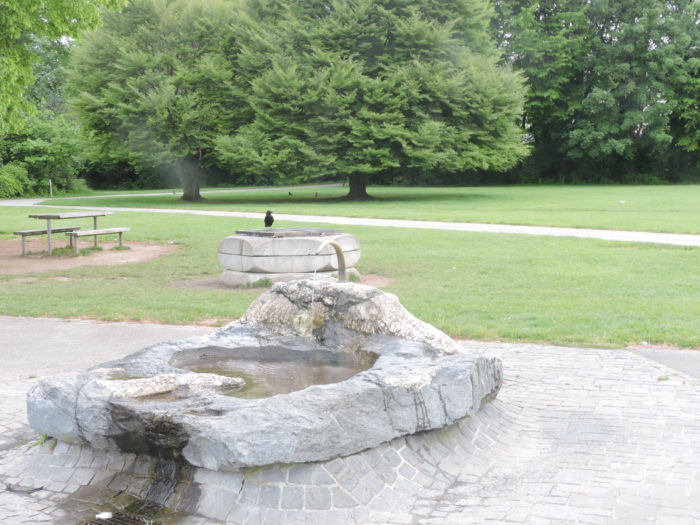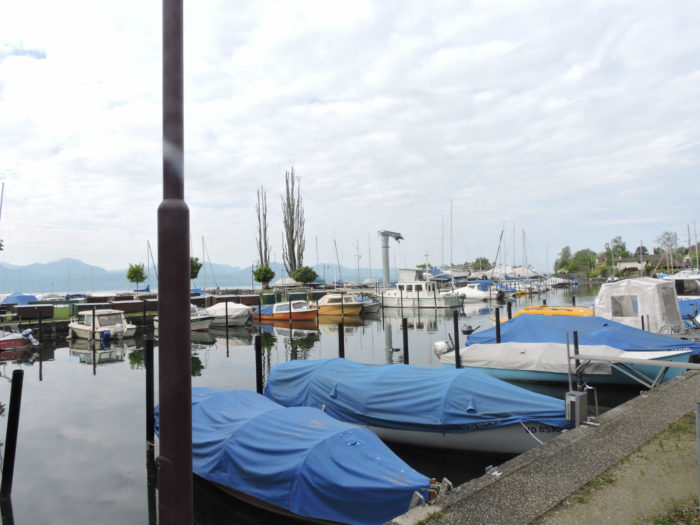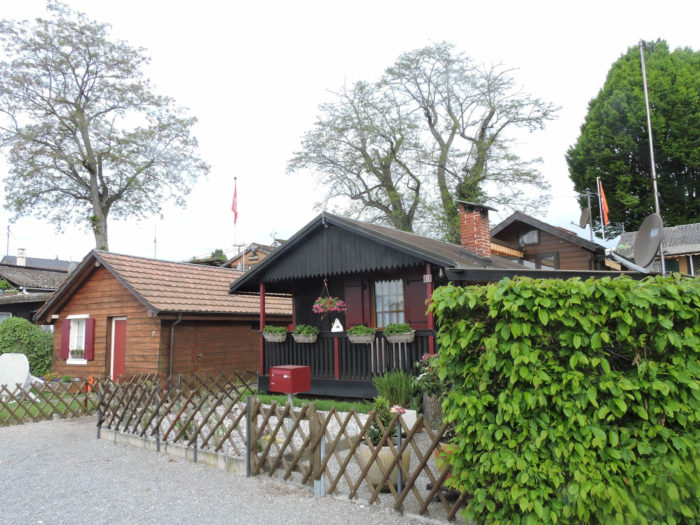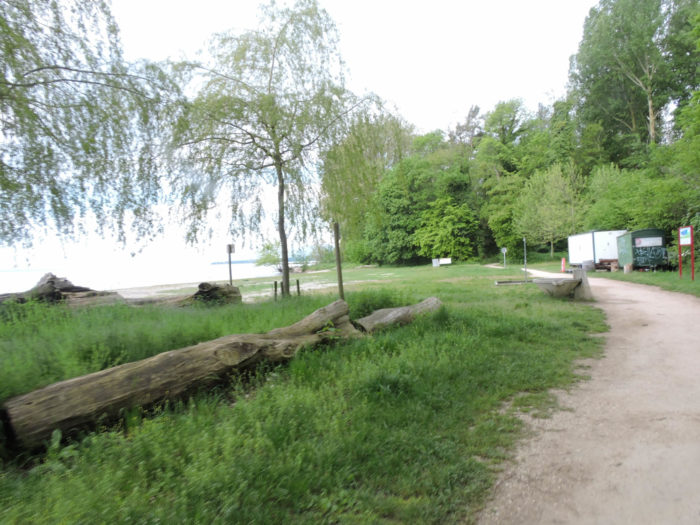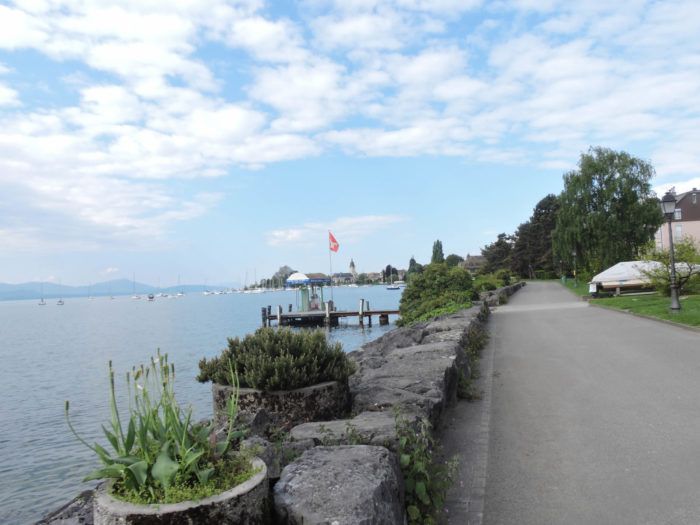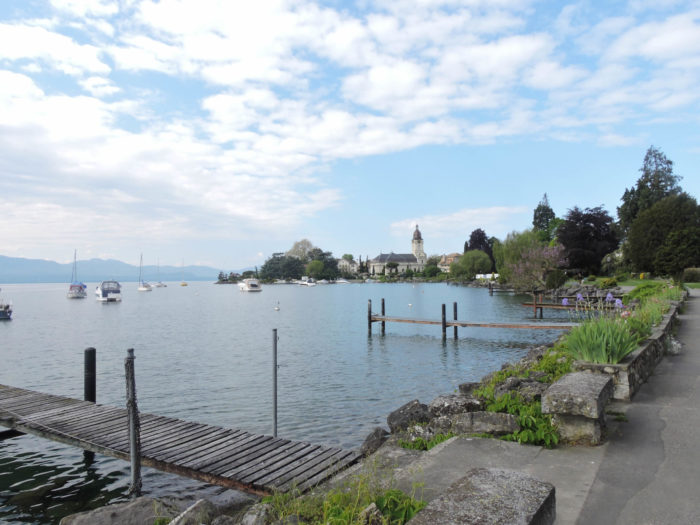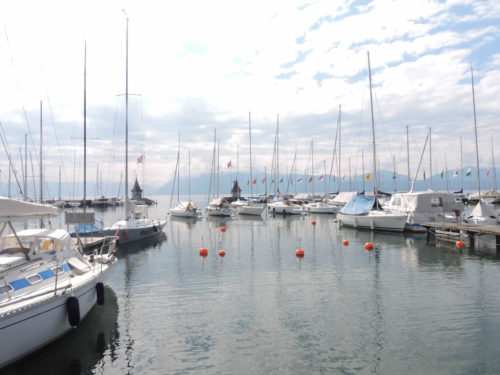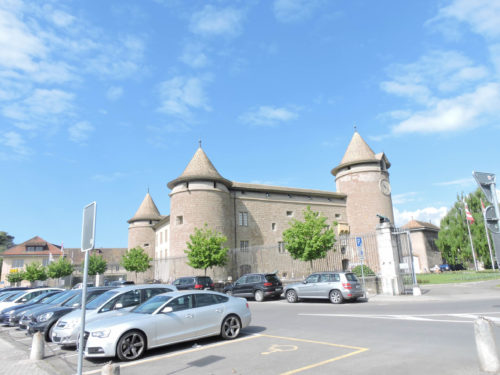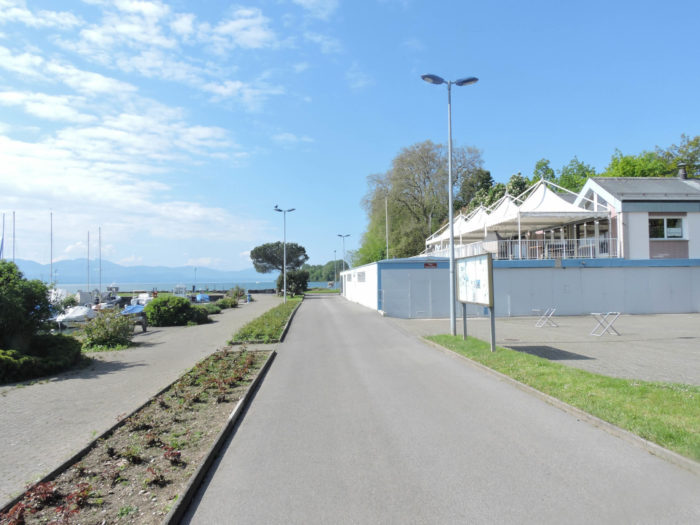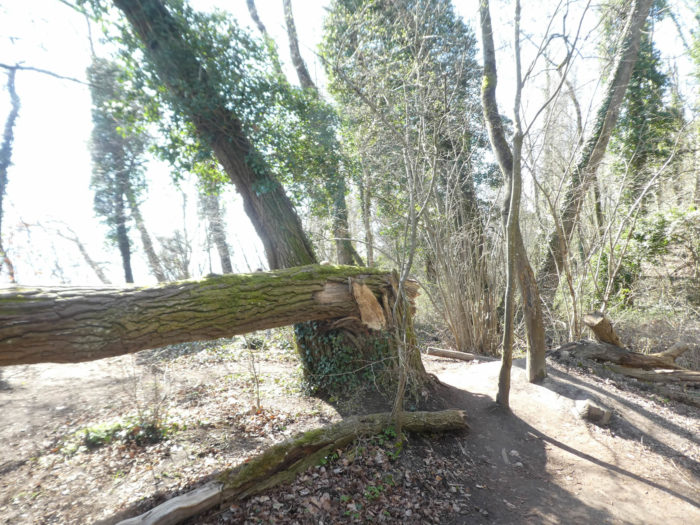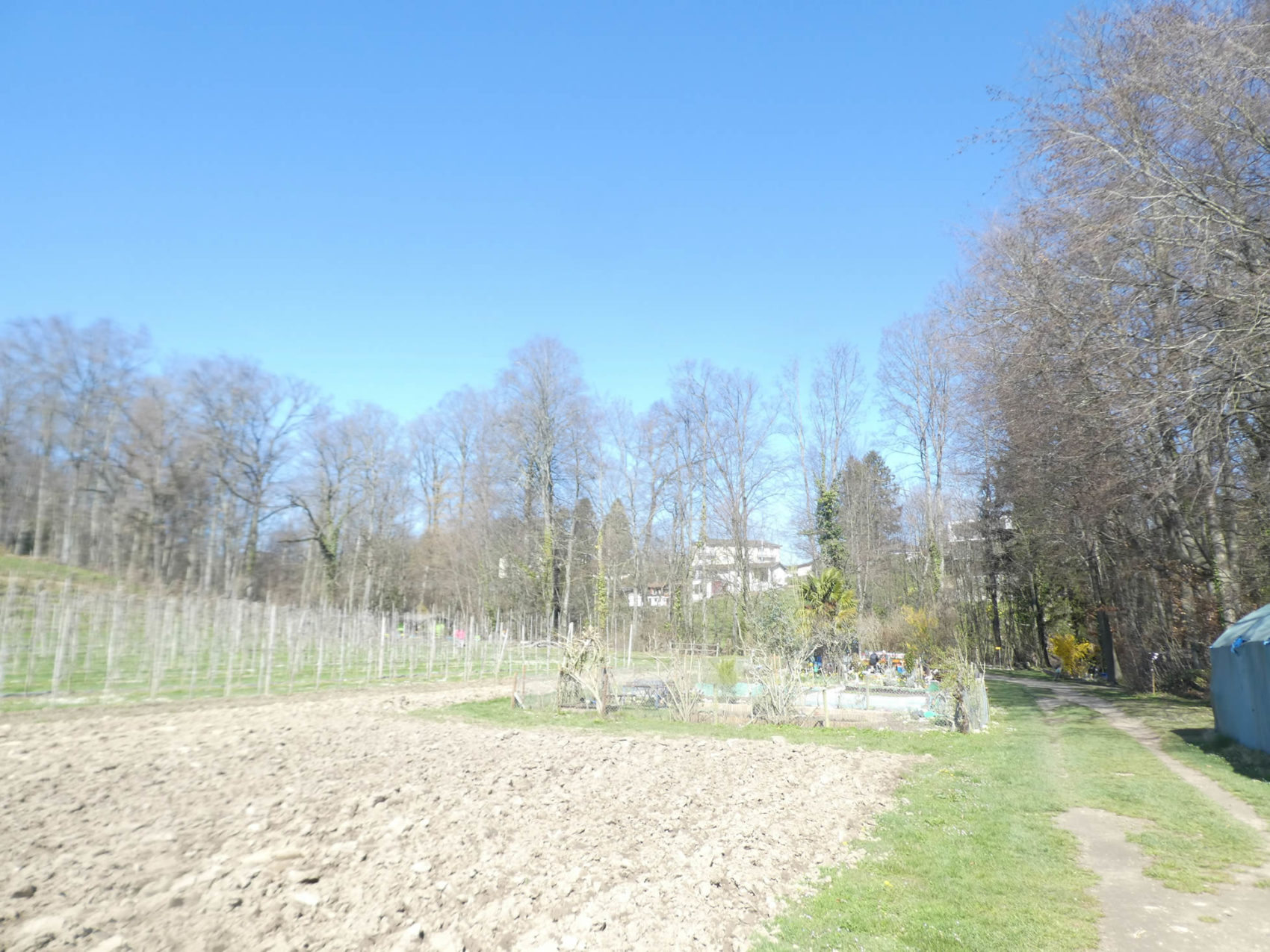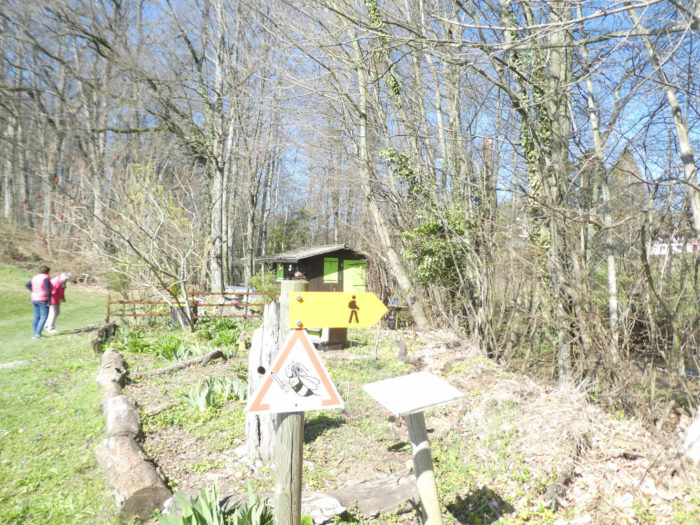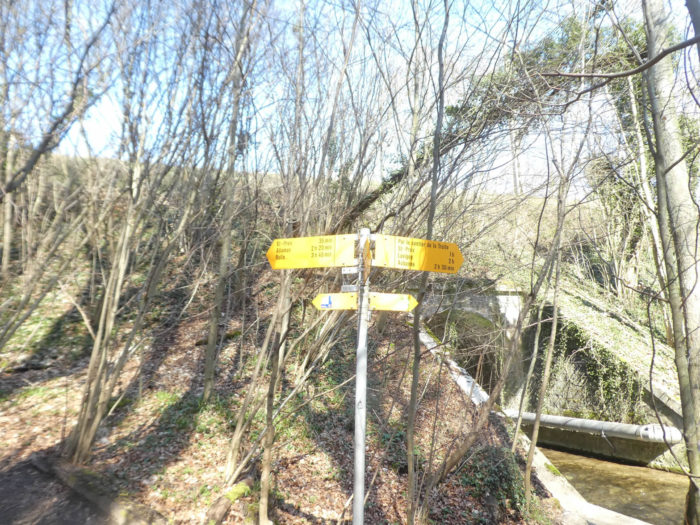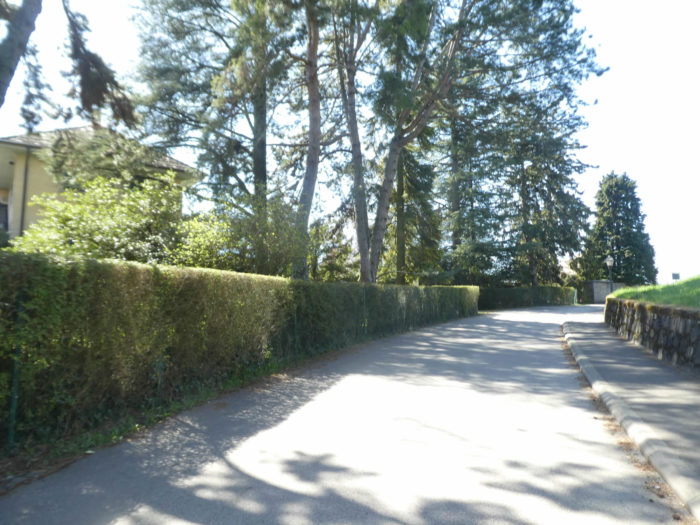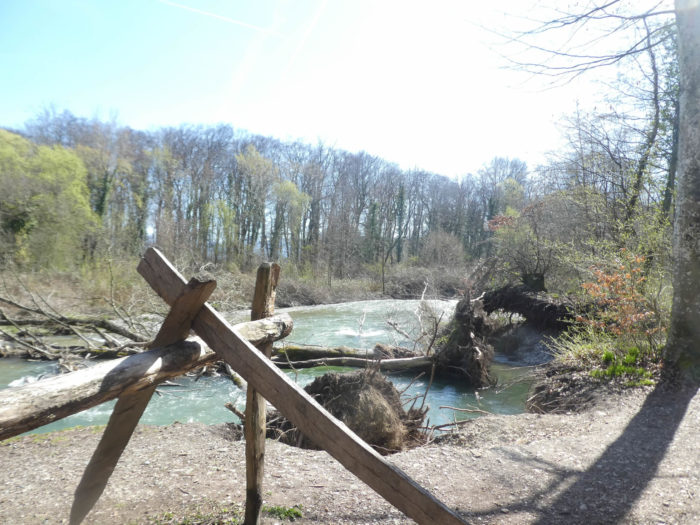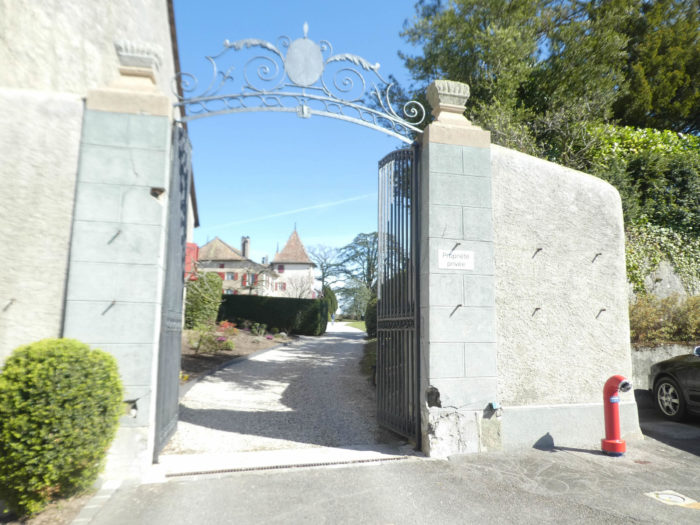A beautiful walk along Lake Geneva
DIDIER HEUMANN, ANDREAS PAPASAVVAS

We divided the course into several sections to make it easier to see. For each section, the maps show the course, the slopes found on the course, and the state of the route (paved or dirt roads). The courses were drawn on the « Wikilocs » platform. Today, it is no longer necessary to walk around with detailed maps in your pocket or bag. If you have a mobile phone or tablet, you can easily follow routes live.
For this stage, here is the link:
https://fr.wikiloc.com/itineraires-randonnee/de-lausanne-ouchy-a-rolle-par-la-via-jacobi-4-new-69088900
|
Not all pilgrims are necessarily comfortable using GPS or navigating routes on a mobile device, and there are still many areas without an internet connection. For this reason, you can find several books on Amazon dedicated to the major Via Jacobi 4 route, which runs through the heart of Switzerland and over the Brünig Pass. The first guide leads pilgrims through the German-speaking part of Switzerland up to Fribourg, while the second continues through French-speaking Switzerland to Geneva. We have also combined these two books into a compact, lighter, and highly practical version. While the descriptions have been slightly condensed, they remain detailed enough to guide you step by step along the way. Recognizing the importance of traveling light, this latest edition has been designed to provide only the essentials: clear and useful information, stage by stage, kilometer by kilometer. The stages have been carefully adjusted to ensure accessibility and alignment with available lodging options. These books go beyond simple practical advice. They guide you kilometer by kilometer, covering all the crucial aspects for seamless planning, ensuring that no unexpected surprises disrupt your journey. But these books are more than just practical guides. They offer a complete immersion into the enchanting atmosphere of the Camino. Prepare to experience the Camino de Santiago as a once-in-a-lifetime journey. Put on a good pair of walking shoes, and the path awaits you.
|

|
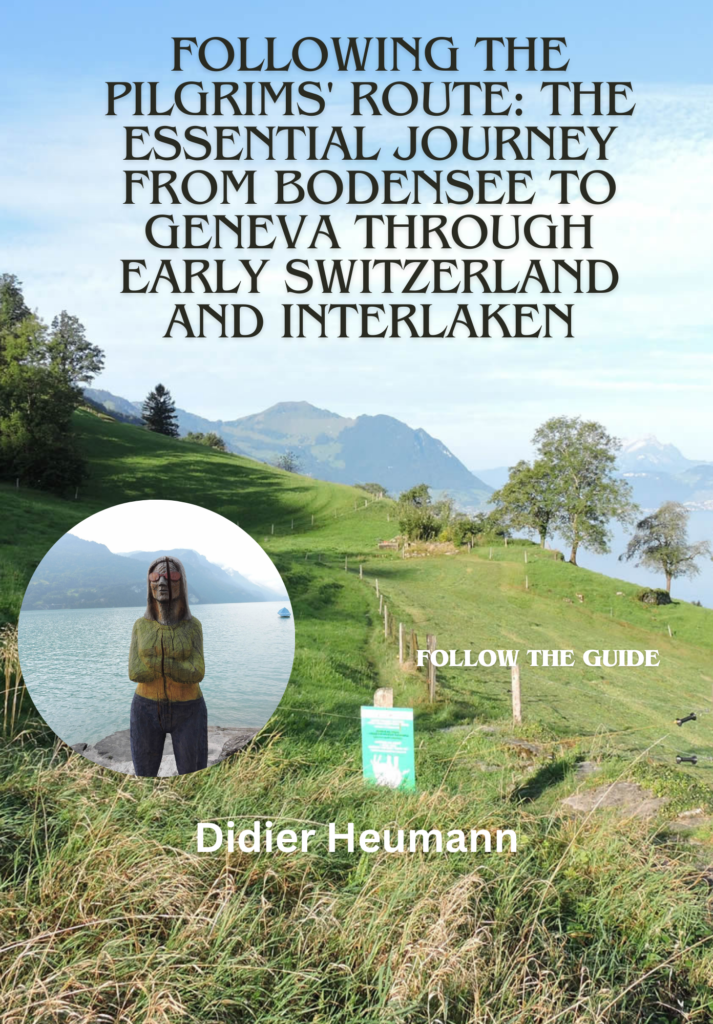 |
Today, you reach what some might deem a jewel on the Camino de Santiago in Switzerland. Yet, as beauty often is, it remains subjective, and those who have endured the more challenging stages of central Switzerland might find solace elsewhere, amidst the serene pastures where cows graze, the tranquil lakes, and the picturesque farms that punctuate the journey. Nevertheless, here stretches an enchanting promenade along the lake, offering the walker almost total freedom, a privilege that becomes scarce beyond Rolle towards Geneva. The lake shores unfold landscapes worthy of the Riviera, with its picturesque ports, magnificent pathways winding through flowers, lawns, and groves. This is none other than Europe’s largest lake, celebrated by poets as a mythical place between heaven and earth, between plain and mountain, between the finite and the infinite. Lamartine considered it a « second creation of the world, » Stendhal as a « vision close to perfect happiness, » and Hugo as « a mirror of cosmic immensity. » Artists, from Courbet to Hodler to Turner, have tirelessly glorified its hues and reflections. If you tread these shores for the first time, it’s highly likely that you too will be captivated by the hidden essence of this marvel of nature.
Lake Geneva (Lac Léman in French), a radiant jewel of Europe, stretches out in an infinite expanse, akin to a canvas painted by the gods. Its calm waters reflect the ever-changing skies, mirroring the shimmering hues of twilight and the golden tones of dawn. Like an emerald set amidst the fertile lands of Switzerland, its shores welcome the graceful ballet of swans and the crystalline laughter of waves gently caressing the shore. Each season adorns the lake with new splendors: in summer, it exudes an enchanting aura, where boaters glide over its sparkling waters, while terraces don colorful umbrellas, offering a tableau of conviviality and relaxation. In winter, a hushed atmosphere envelops its banks, draping the shores in a cloak of mist and transforming reflections into a mirror of ice, where the snow-capped peaks of the surrounding Alps are mirrored.

Difficulty level: The day’s elevations (+88 meters/-82 meters) are almost forgettable, but this stage stretches in length. The slopes are gentle, barely exceeding 5% incline. A tranquil stroll, far from the difficulties encountered in some previous stages.
State of the Via Jacobi: The paths here have a slight advantage, although their nature may vary. Indeed, the surface is sometimes paved, sometimes beaten earth. However, on the quays, it’s often asphalt that underlies your steps, providing a more uniform surface:
- Paved roads: 13.6 km
- Dirt roads : 16.3 km
Sometimes, for reasons of logistics or housing possibilities, these stages mix routes operated on different days, having passed several times on these routes. From then on, the skies, the rain, or the seasons can vary. But, generally this is not the case, and in fact this does not change the description of the course.
It is very difficult to specify with certainty the incline of the slopes, whatever the system you use.
For those seeking « true elevations » and enthusiasts of genuine altimetric challenges, carefully review the information on mileage at the beginning of the guide.

Section 1 : On the quays of Lausanne
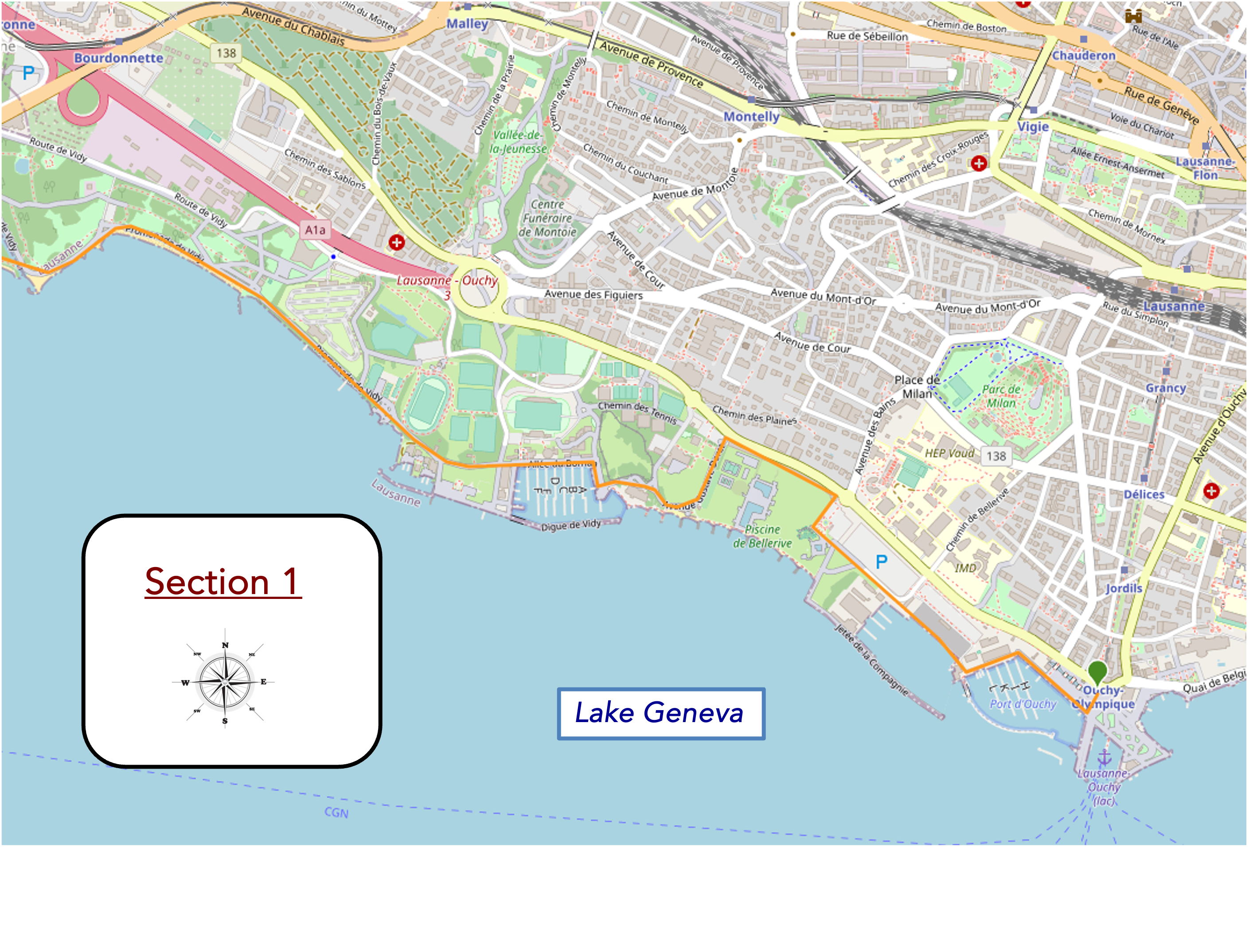
Overview of the route’s challenges : course without any difficulty.
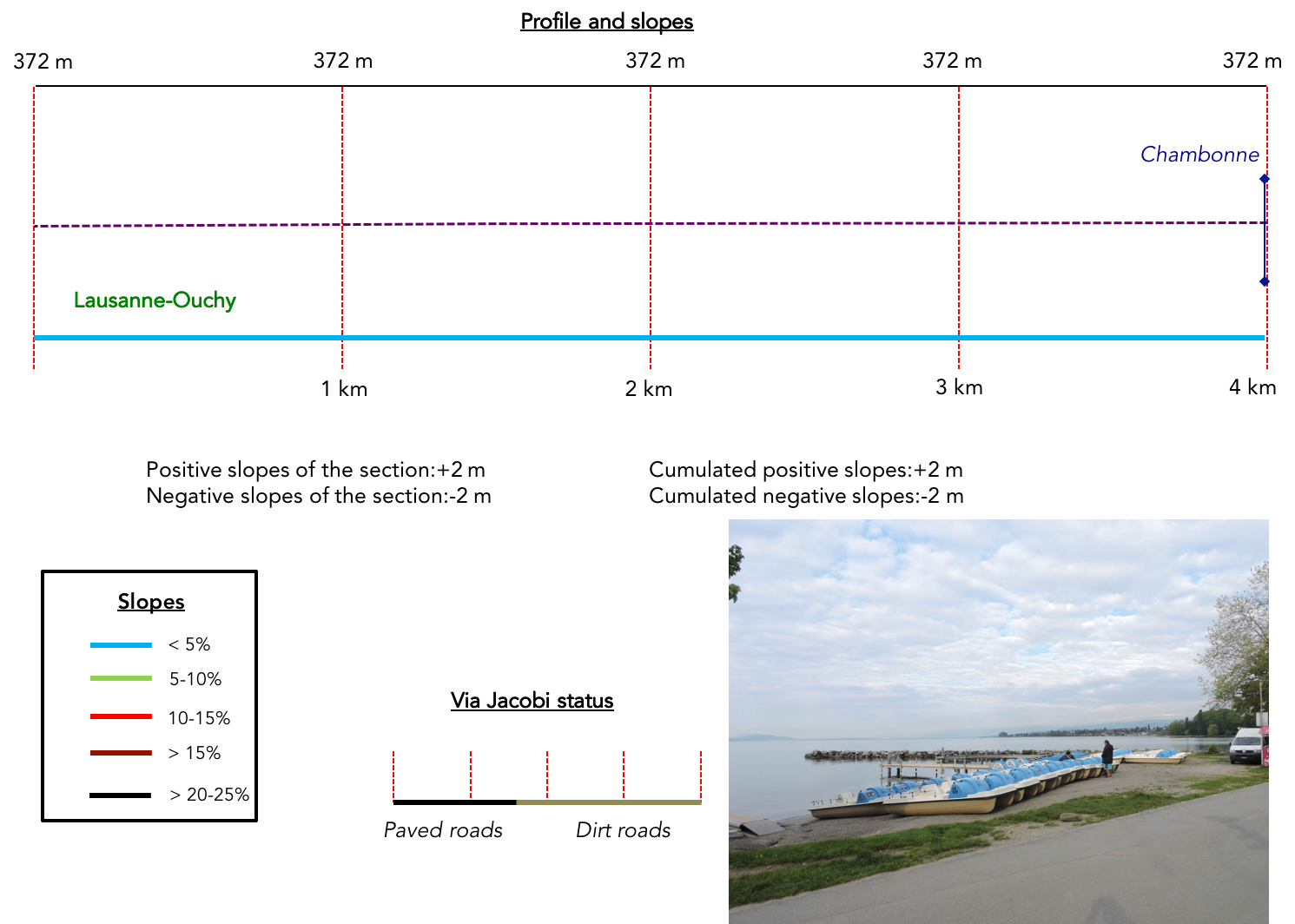
|
To escape the tangled streets of Lausanne, to avoid plunging into the pulsating metropolis, the safest solution proves to be the metro, an underground maze that leads to the outskirts of the city, to Ouchy, on the Place de la Navigation, where Lake Geneva stretches out into an infinite blue expanse, a mirror of the heavens.
|
 |
 |
| A valuable piece of advice, whispered from insiders to curious travelers: forsake the temptation of the shore, where tracks crumble into dead ends, to embrace Rue de Rhodanie, a sidewalk etched into urbanity, a narrative paved with asphalt and perspectives. |
 |
 |
The street stretches languidly, flanked by parks of metal and concrete, by noisy festivities where ephemeral lights swirl, before revealing, on the horizon, the sumptuous entrance of the Bellerive swimming pool, an urban oasis with sparkling waters, reflections of a city in motion in the summer.
|
 |
 |
| Season of bronzed bodies and children’s laughter, season where the shores are off-limits to pilgrims, season of paths diverted to other horizons. Rue de Rhodanie continues, impassive, crossing the prestigious headquarters of Nespresso, before giving way to the call of the woods. |
 |
 |
| There, at the crossroads, the world opens up to you like a fan of possibilities. Choosing any leftward path that plunges towards the tranquil waters means delving into Vidy Park, a bustling haven of life, a stage where everyday scenes play out, where echoes of a bygone National Exhibition resonate. |
 |
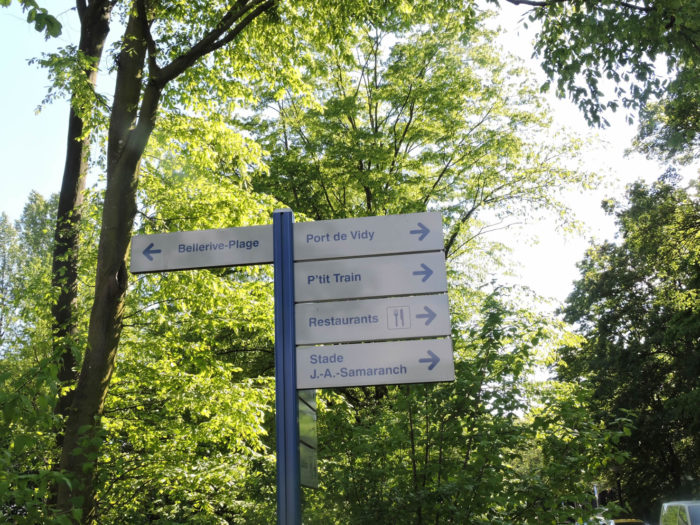 |
| In this urban garden, enclosed between asphalt and waves, remnants of the past stand tall, witnesses to glorious sporting events, such as the Pierre de Coubertin Stadium, once the arena of athletic feats. But the park is above all a theater of strolls and idleness, where tender grass invites abandonment. If by chance you tread these shores on sunny weekends, your senses will be enchanted by the enticing aroma of grilling sausages and crackling barbecues. The air itself seems laden with these appetizing fragrances, awakening the taste buds and inspiring a desire to join in these outdoor culinary festivities. |
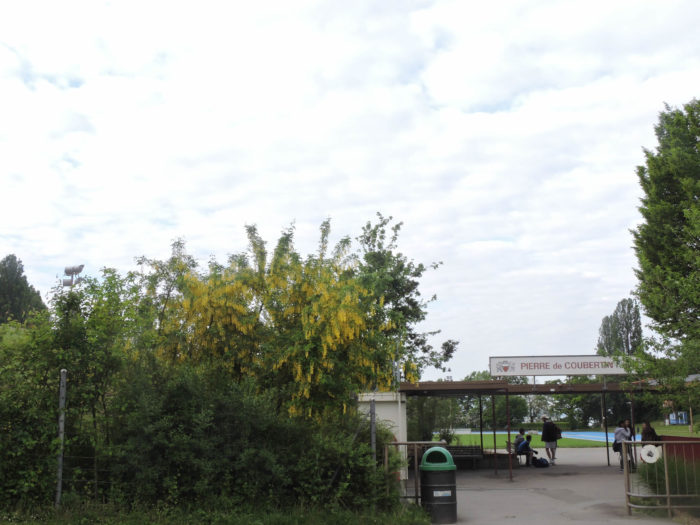 |
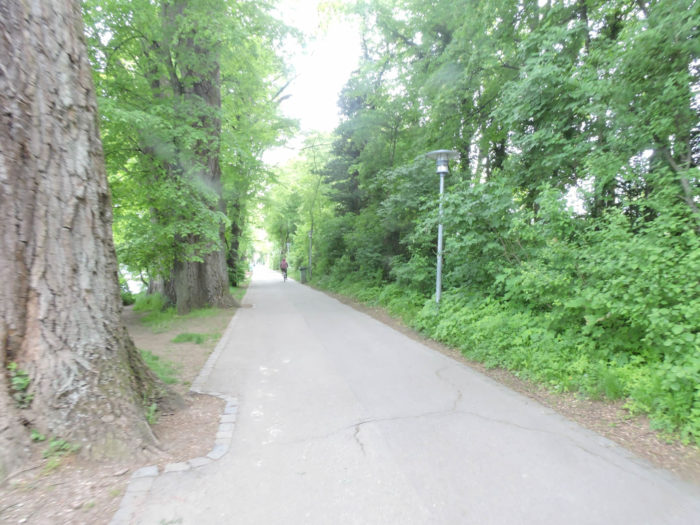 |
No doubt, you still tread the Via Jacobi 4, the sacred artery of the Way of St. James in Swiss territory. Necessary precision, cryptic warning: the signs become enigmatic, and the wayward walker must be content with the vague « Hiking Tourism, » with no certainty about their path. But you have no risk of getting lost here.
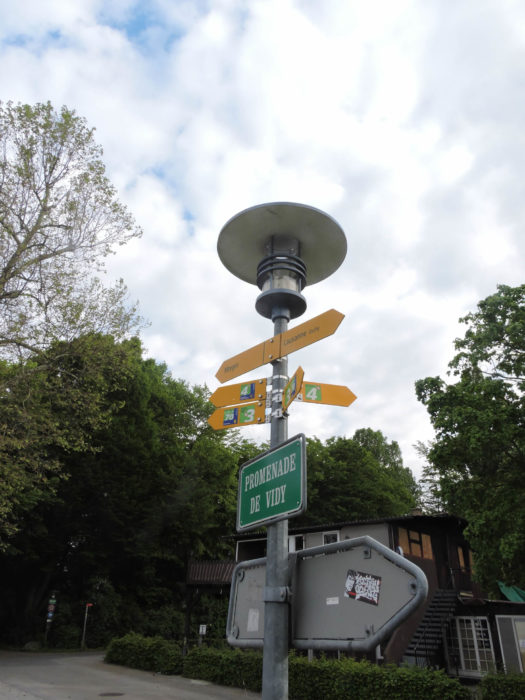
| The route then delves into the Bourget-Wood, a cathedral of greenery where trails wind between secular trees, alternately caressing the shores of the lake or getting lost in the depths of the forest. A place of meditation and movement, where crowds stretch out, bathed in light. |
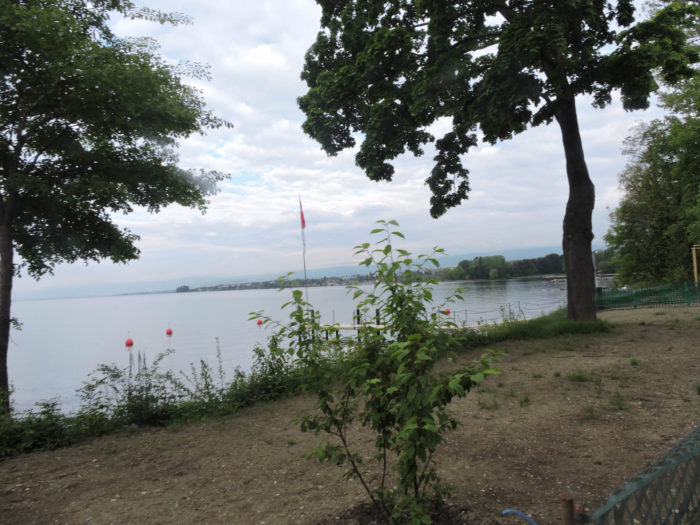 |
 |
From the other shore, the gaze embraces the Dents-du-Midi, majestic totems emerging from the waves, haughty guardians of the Valais Alps, their silhouettes cut against the ethereal backdrop of Mont Blanc.

| At the edge of the woods, after 4 kilometers of walking from Ouchy, Lausanne gives way to St Sulpice, leaving behind it the Chamberonne, where waters mingle in a harmonious ballet, a fleeting marriage between the lake’s waters and the impetuous stream. An elusive border, where reality merges with dreams. |
 |
 |
Section 2 : Crossing St Sulpice

Overview of the route’s challenges : a route without any difficulty.

|
From the shaded paths of Chamberonne, the journey unfolds in a tranquil ballet under the canopy of grand robinias, ancient guardians of these charming surroundings.
|
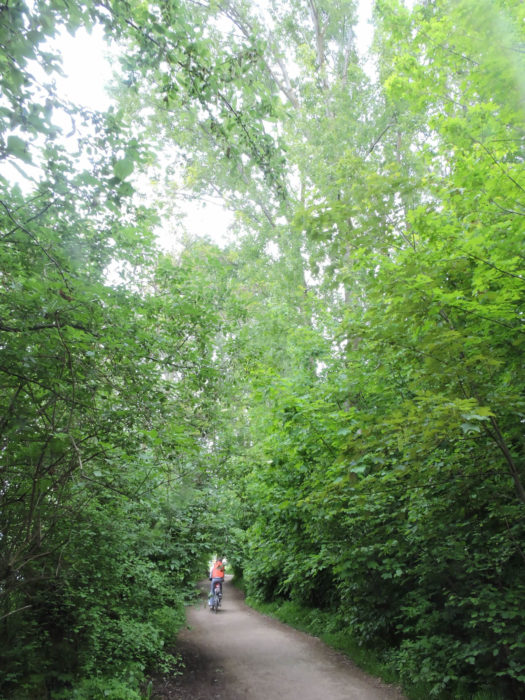 |
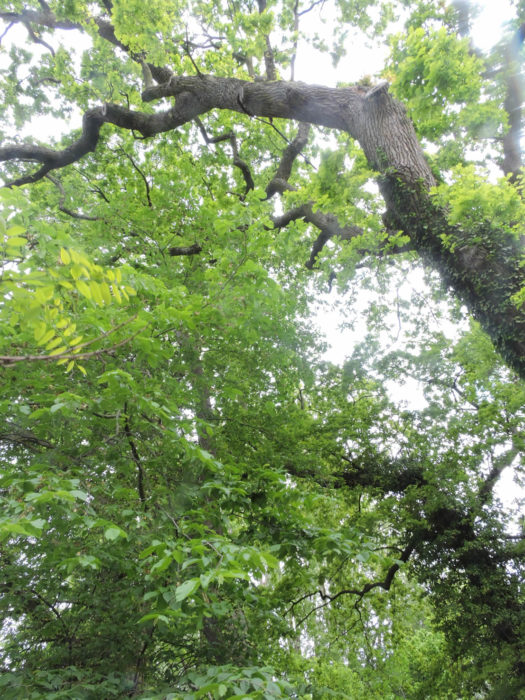 |
| A generous path of beaten earth winds through the heart of Lausanne’s new university campus, a cradle of knowledge that, despite its young years by the lake, already breathes the wisdom of the ancients. This campus is vast, encompassing both the University and the Swiss Federal Institute of Technology in Lausanne, the other being in Zurich, boasting 16 Nobel Prizes. |
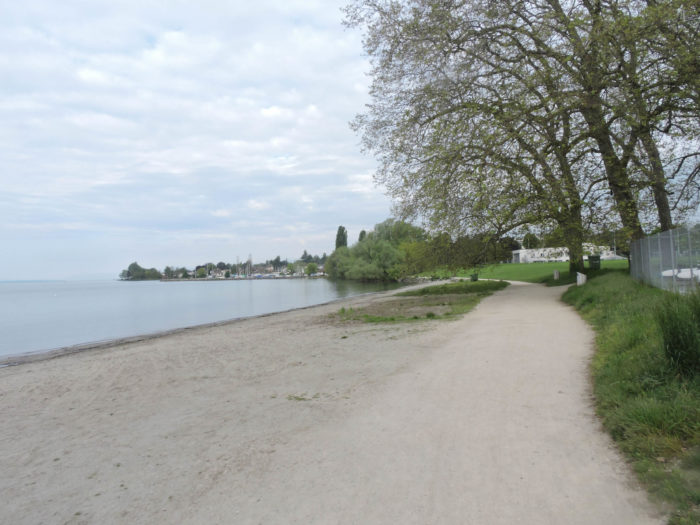 |
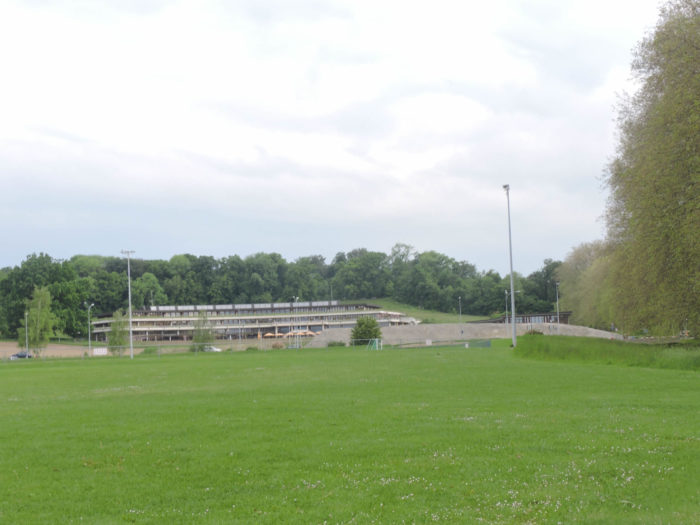 |
And then, as if by enchantment, it opens onto the Port des Pierrettes, a haven where boat sails caress the wind and weekend pavilions whisper tales of tranquility. These modest structures, imbued with simplicity and resilience, marked by sea spray and the sun’s embrace, recount the history of the men who shaped these shores, from generation to generation.
|
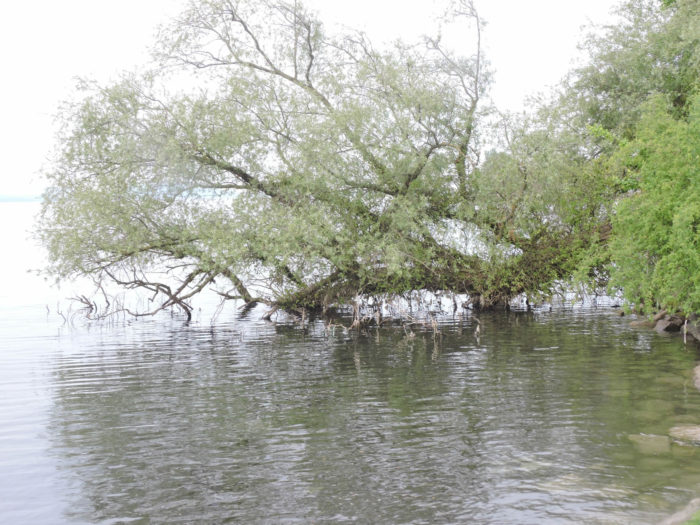 |
 |
The route, upon leaving this port, meanders along a narrow path, skirting the waters murmuring softly against the stones, creating narrow passages where the lake’s mystical charm works its magic. Across, like a monarch of the skies, stands Mont Blanc, unwitting observer of your wanderings. Before you, like a sleeping nymph, the silhouette of Evian unfolds on the French shore.
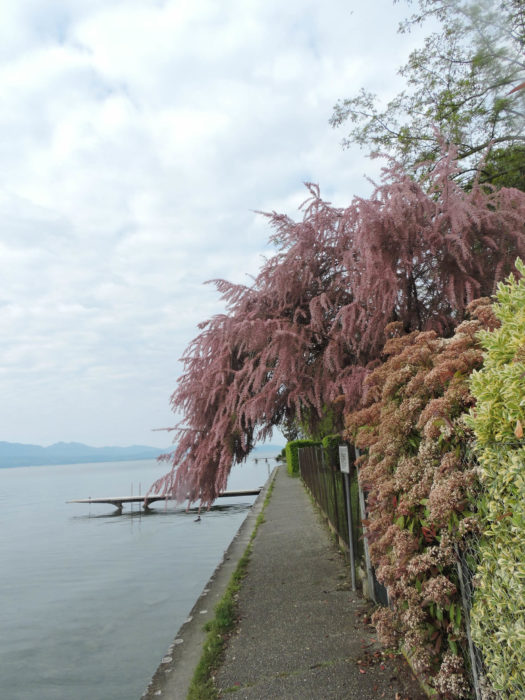
| A little further, your steps lead you to Pelican Beach, a coveted shore where crowds gather in summer, eager for the sun’s benevolent caress and the soothing murmur of the waves. |
 |
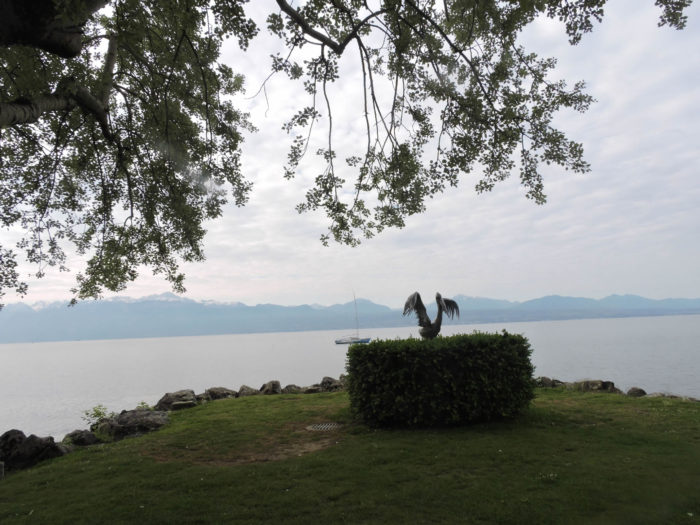 |
| From this beach, the path continues along the shore, where, in a gesture of generosity, some property owners occasionally open their gates to the stroller. Alas, such courtesy is not always found on the shores of the majestic Lake Geneva, despite the absence of contrary law. Swiss law does not mandate freedom of passage along lake shores. |
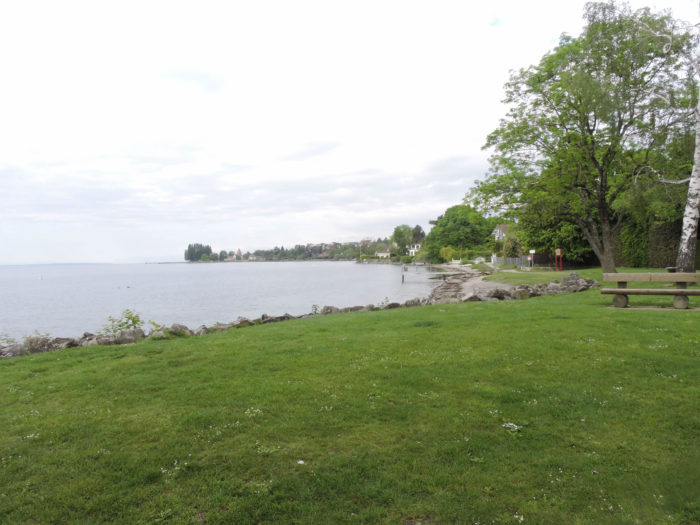 |
 |
| But soon, the tranquility of the banks fades away, the gentle murmur of the waters diminishing. The Via Jacobi, like an intrepid traveler, prepares to cross the village of St Sulpice, a bitumen wanderer nestled among elegant residences exuding bourgeois tranquility. Here, every parcel exhale order and cleanliness. |
 |
 |
| Sometimes, the street timidly approaches the lake, then reluctantly retreats, as if afraid to break the fragile charm that binds the shores to solid ground. |
 |
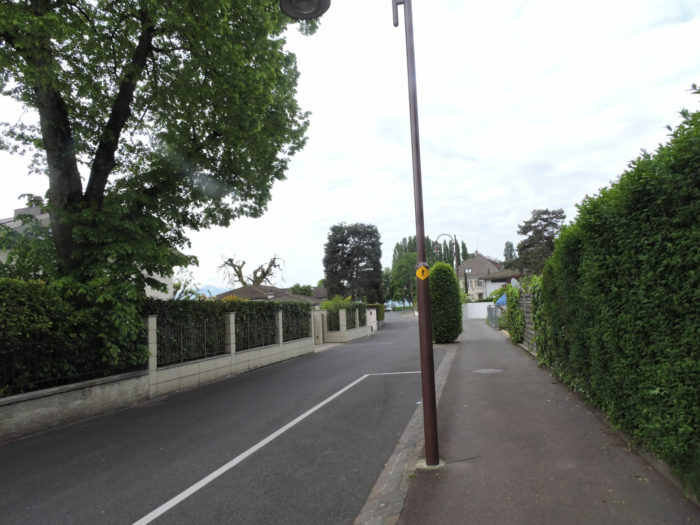 |
| And then, suddenly, it emerges at the St Sulpice dock, where visitors’ footsteps echo on the cobblestones. |
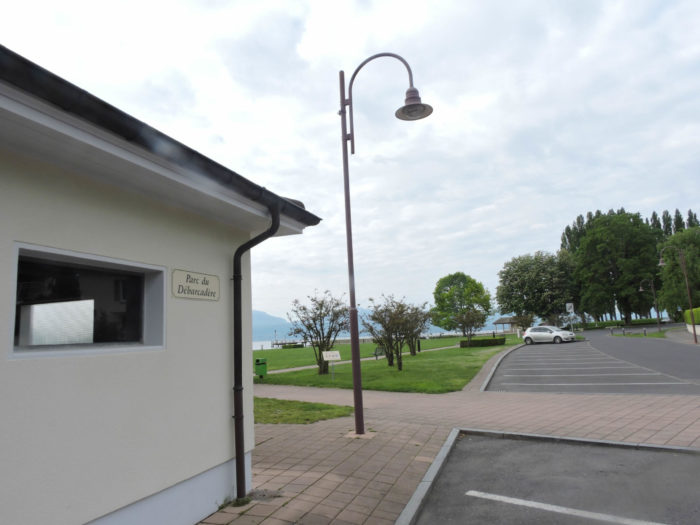 |
 |
| Nearby stands the majestic Romanesque church of St Sulpice, an immutable witness to centuries gone by. Erected in the 11th century and initially dedicated to Saint Sulpice, then to Saint Mary Magdalene, it reigns, flanked by a once prestigious priory. Fully restored in the early 20th century, this venerable building is now the refuge of a fervent Protestant community. |
 |
 |
| Barely has the visitor left the church’s forecourt when a dirt path presents itself, gently sloping down towards the lake’s shores, offering to dazzle their eyes with the enchanting spectacle of glistening waters and boundless horizons. Despite the easy accessibility of the lake’s shores, the ballet of bathers remains strangely rare, like a discreet melody in a concert of silence. The limpid waters of Lake Geneva, though inviting and refreshing, sometimes seem neglected, as if the shores offer much more than a mere swim. Perhaps this is the enigmatic charm of these shores: their ability to enchant wandering souls, plunging them into silent contemplation of endless horizons. Where other waters would be filled with laughter and splashes, Lake Geneva prefers tranquility, the murmur of waves blending harmoniously with the breath of the wind. Unless it’s caution guiding the bathers’ steps, aware of the mysteries hidden in these deep waters. |
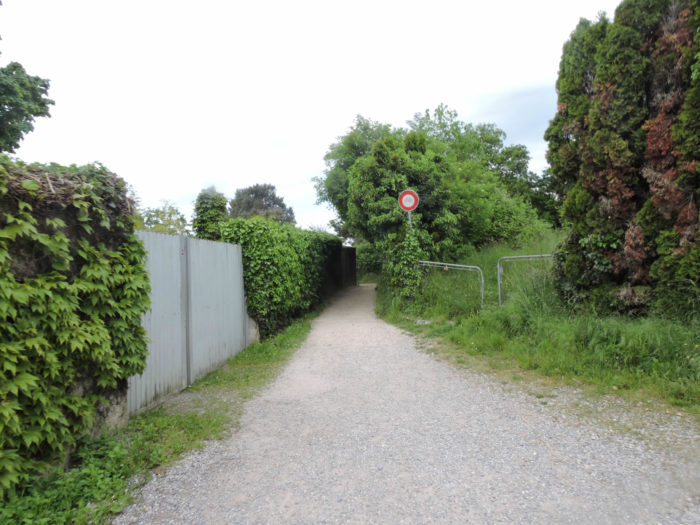 |
 |
| True to its purpose, the path hugs the shore, sometimes overlooking private rails for boat exits, silent witnesses to the incessant ballet of boats sailing with the currents. Here, everyone is invited to share the beauty and benefits of the lake, where life flows like an enchanting melody. It’s magical once again around here. |
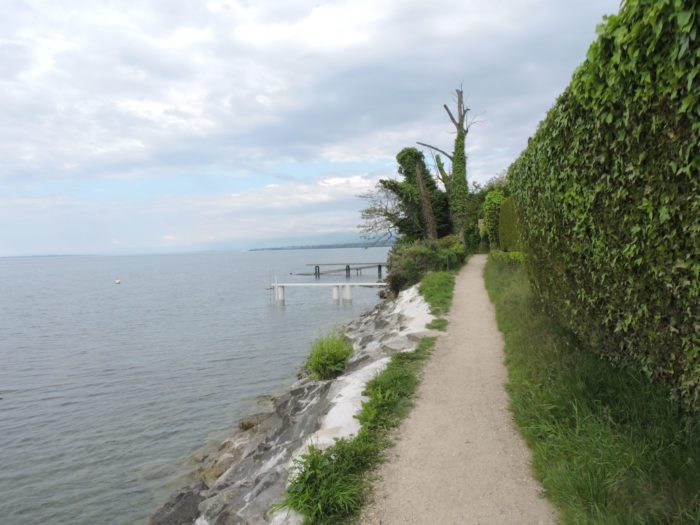 |
 |
| Then, it succumbs to a winding path, crossing the picturesque area of Laviau and Port Tissot. These marinas, havens of peace for light vessels, contrast with the bustle of large ships crisscrossing the waters, from one port to another, in an incessant dance between France and Switzerland. |
 |
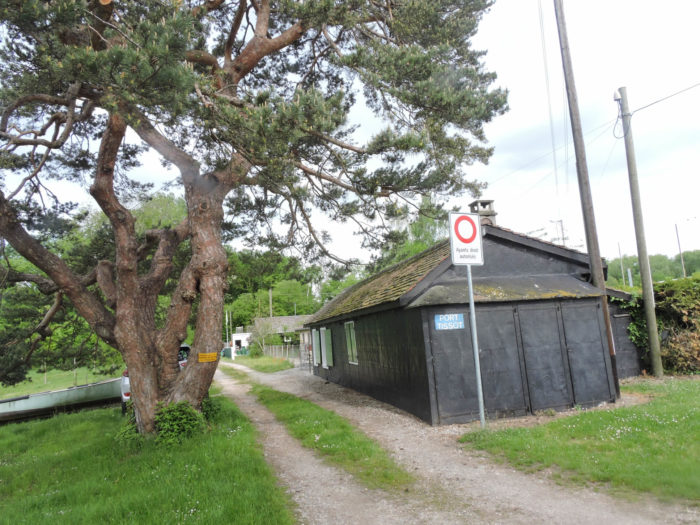 |
Section 3 : On the docks of Préverenges and Morges

Overview of the route’s challenges : a course without any difficulty.
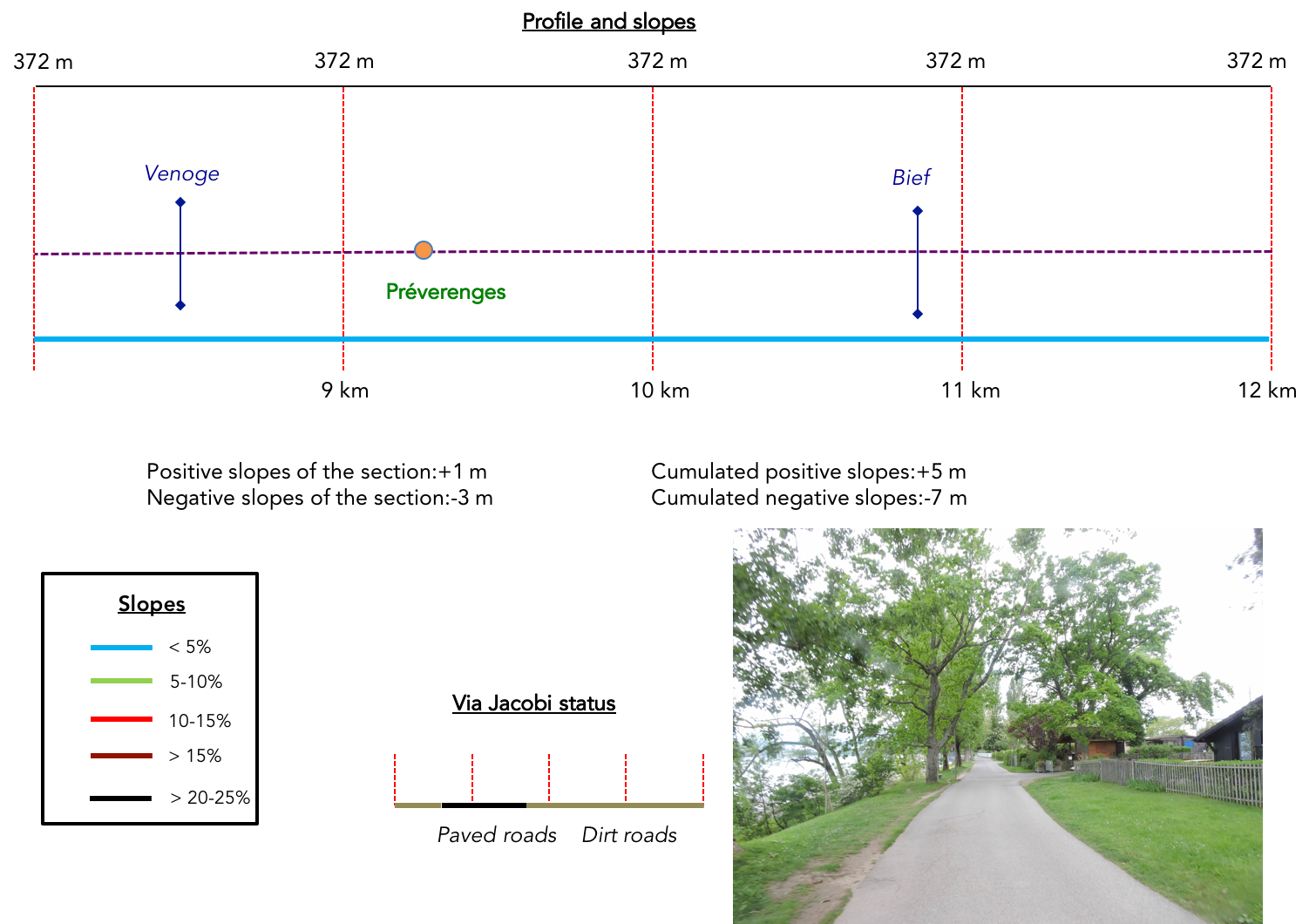
Shortly after, the path gently veers away from the shores, plunging into the protective cover of majestic deciduous trees. These shaded alleys stretch like pleasure arteries, inviting an escape from time. Every step resonates in harmony with the natural beauty that reigns here, an anthem to the unfolding beauty. One readily surrenders to this earthly symphony, lulled by the murmuring of the foliage.
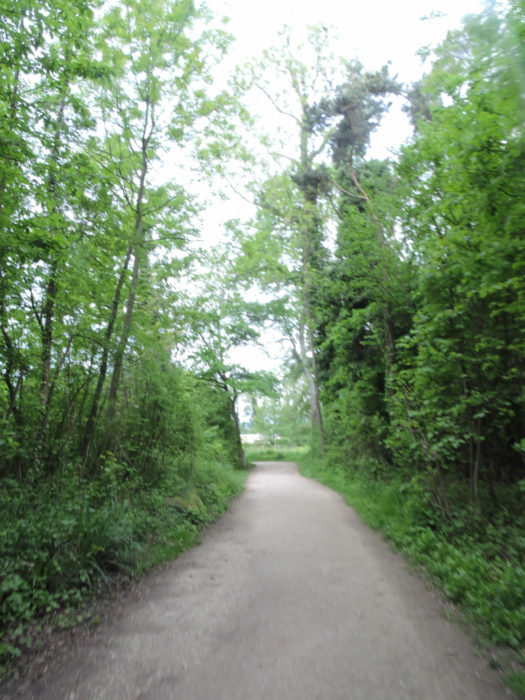
| Further along, the path crosses the waters of the Venoge, a carefree river that merges with its elder, the majestic Lake Geneva. In this aquatic dance, the two watercourses unite, weaving an unbreakable bond between their currents. It’s a living tableau where shades of blue merge into an infinite palette, revealing the poetry of water in perpetual motion. |
 |
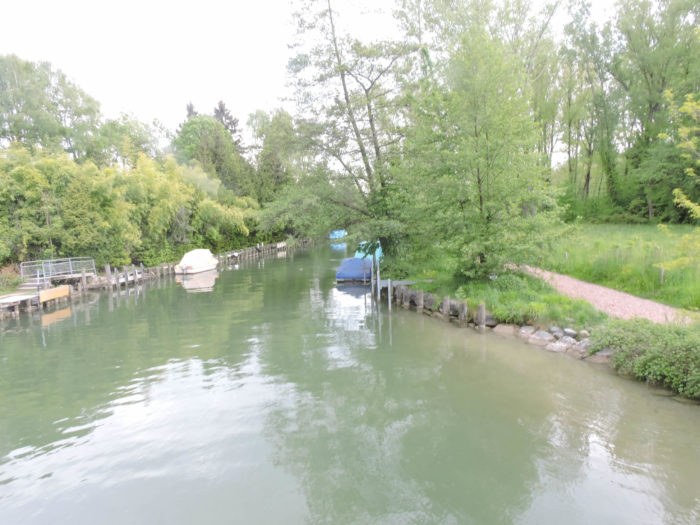 |
| After crossing the bridge over the Venoge, the dirt path returns to the lakeshore, gracefully heading towards Préverenges. Here, rustic simplicity harmoniously blends with the elegance of sailboats and pleasure cabins, creating an enchanting atmosphere imbued with lakeside charm. |
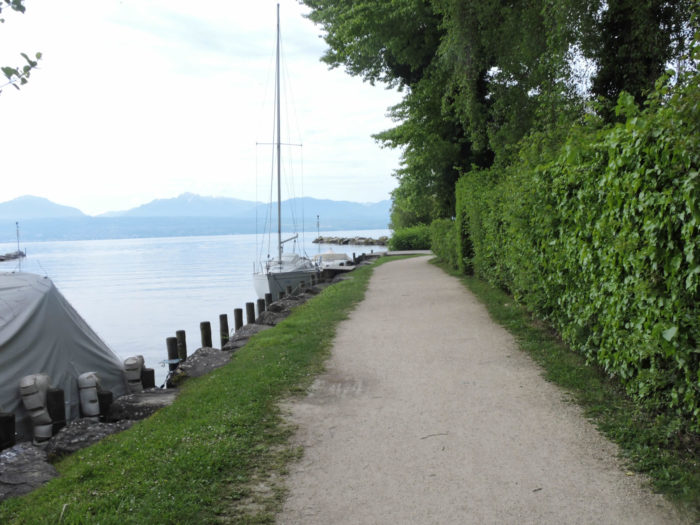 |
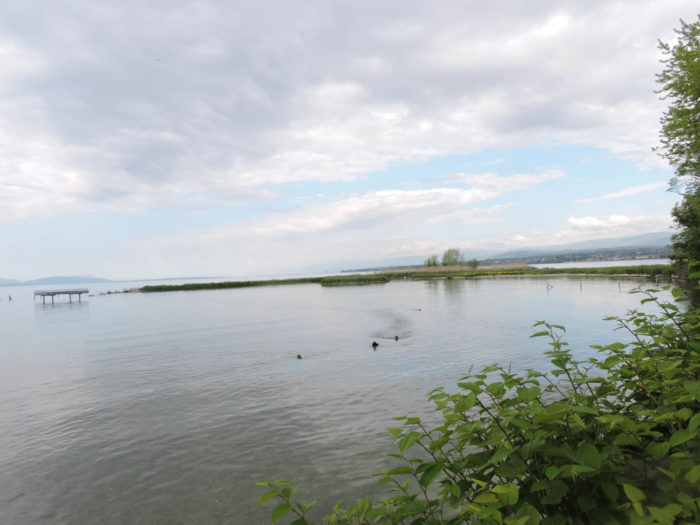 |
| At the Port of Préverenges, the route continues on asphalt, where sailboats sway to the soothing rhythm of the waves. The atmosphere caresses the senses, while the sun’s rays dance on the waves, illuminating this maritime tableau with an enchanting aura. |
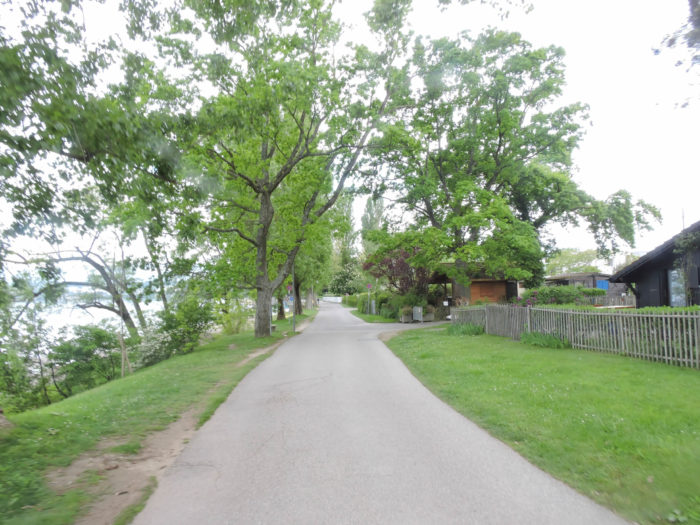 |
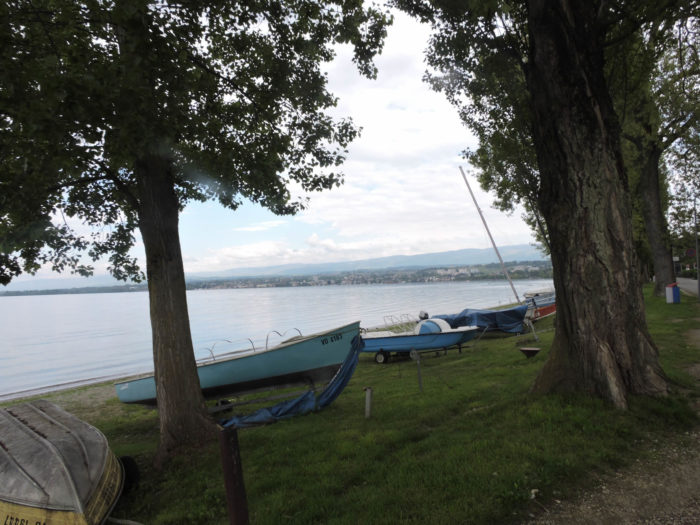 |
| The road, almost straight, runs along the beach with a tranquil persistence. The small dining establishments and cabins seem to patiently await the influx of visitors, offering a welcoming refuge on sunny days. It’s an irresistible invitation to relaxation and delight. |
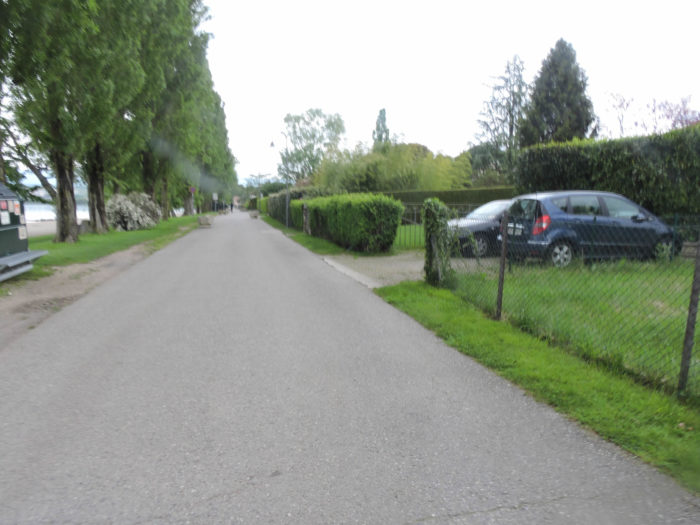 |
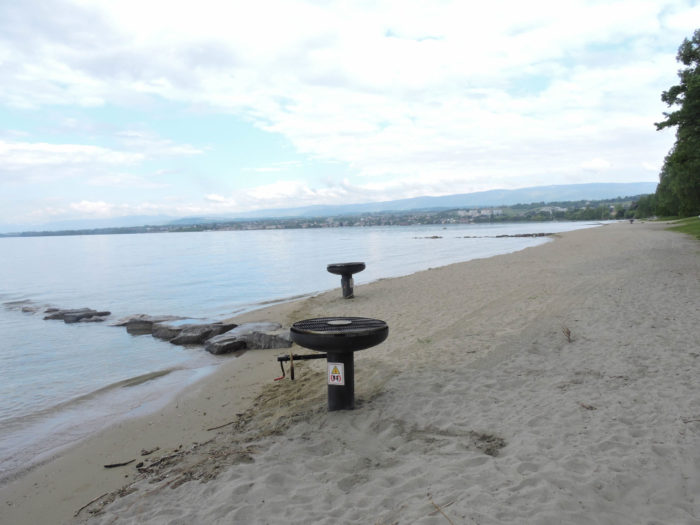 |
| As the road veers away from the beach, a dirt path takes over, faithfully following the contours of the shore. On the horizon, the outlines of Morges’ suburbs begin to emerge, offering a breathtaking spectacle that enraptures the senses. It’s an incredible moment, suspended in time, a living painting where nature and urbanity blend in perfect harmony. |
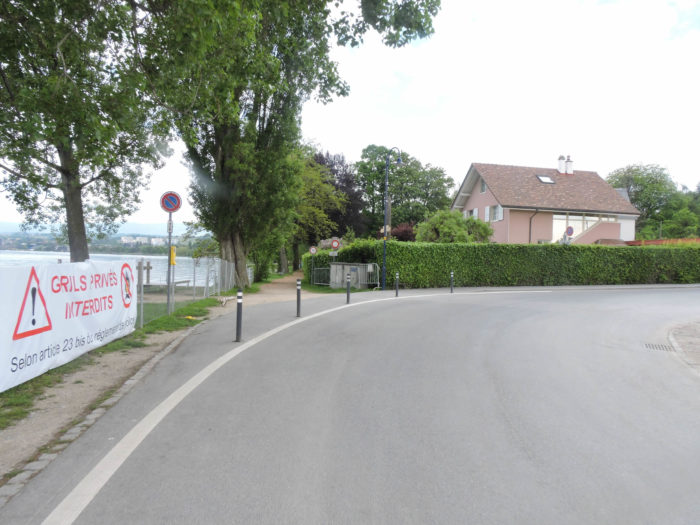 |
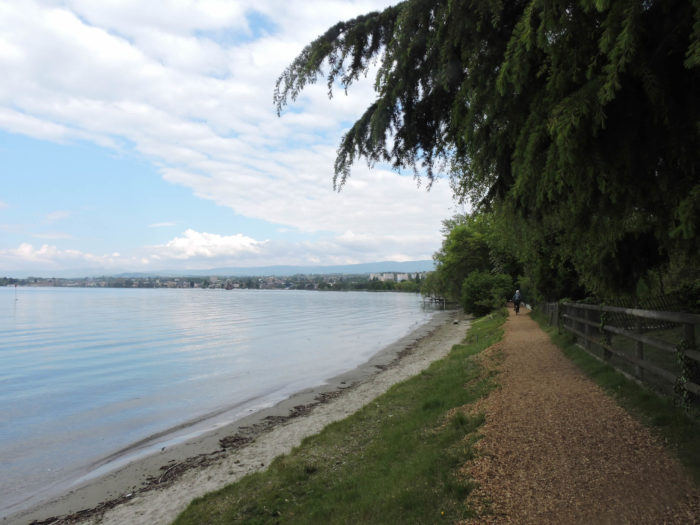 |
| The path then winds along Avenue de la Plage to Vertou Park, where a vast expanse of lawn stretches to the clear waters. It’s a haven of peace where nature lazily stretches, reveling in every sunbeam caressing its gentle green hills. One finds oneself dreaming of establishing a humble abode here, bathed in the softness of this idyllic landscape. |
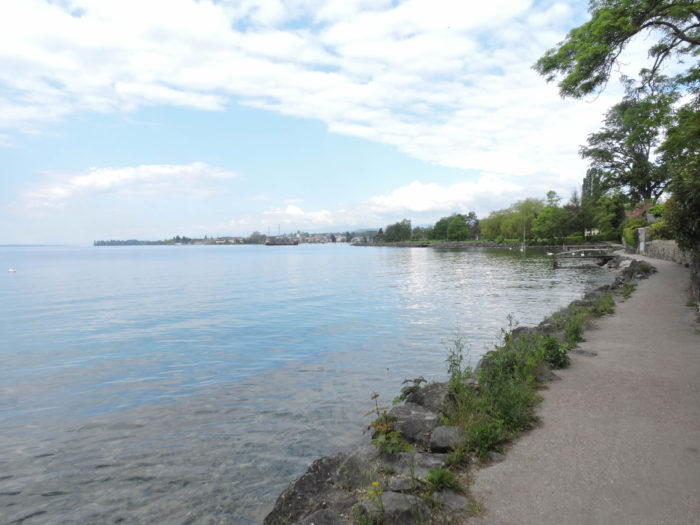 |
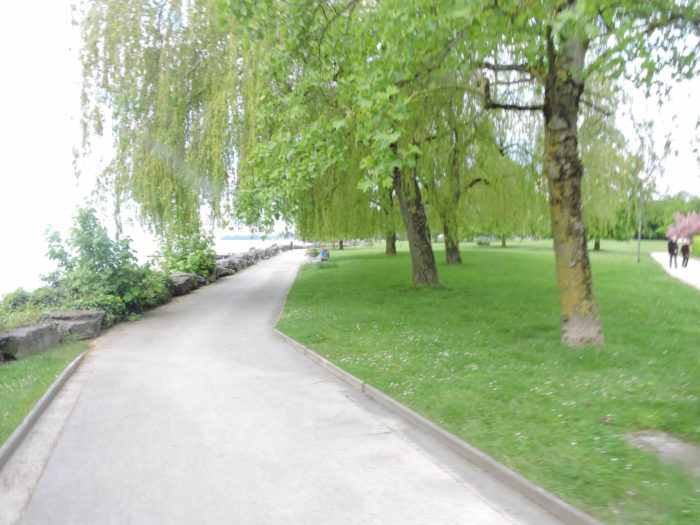 |
| There, the route returns to asphalt and runs alongside the small port of Bief, where boats sway with the tranquil currents. It’s an incredible place, where every moment is imbued with tranquility and serenity, offering a refuge to the soul in search of respite. |
 |
 |
| The Via Jacobi continues its journey, crossing the modest river of Bief to venture a little further into Vertou Park, on the outskirts of Morges. It’s an incursion into a world where nature reigns supreme, enveloping every step in its timeless majesty. |
 |
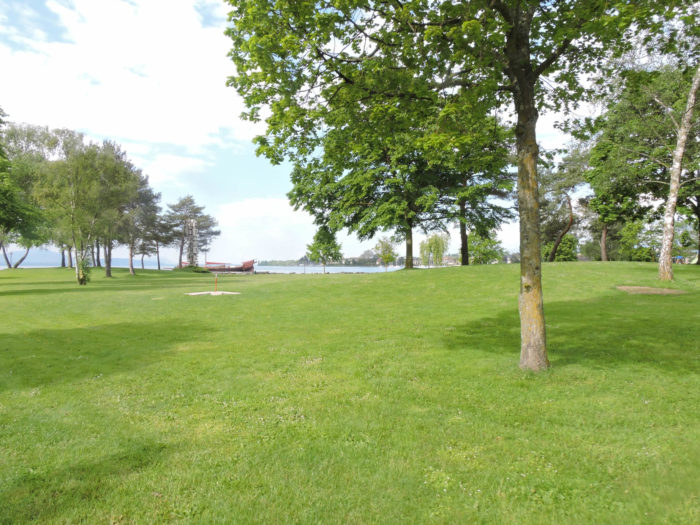 |
| At the exit of the park, the trail merges into the long Quai Igor Stravinski, which leads to the dock of Morges. This singular promenade offers a unique experience, rocked by the murmurs of the waters and the gentle caress of the wind. Between the large rocks that line the shore and the small pontoons that disappear into the crystalline waters, it’s a sensory journey where one is carried away by the magic of the landscape. The Promenade des Anglais is often evoked for absolute beauty, but other places, like these, rival in beauty and splendor. |
 |
 |
Section 4 : Between lake and woodland

Overview of the route’s challenges : a course without any difficulty.

| Life flows peacefully along the quay, between the green parks and the sumptuous mansions lining the lake. |
 |
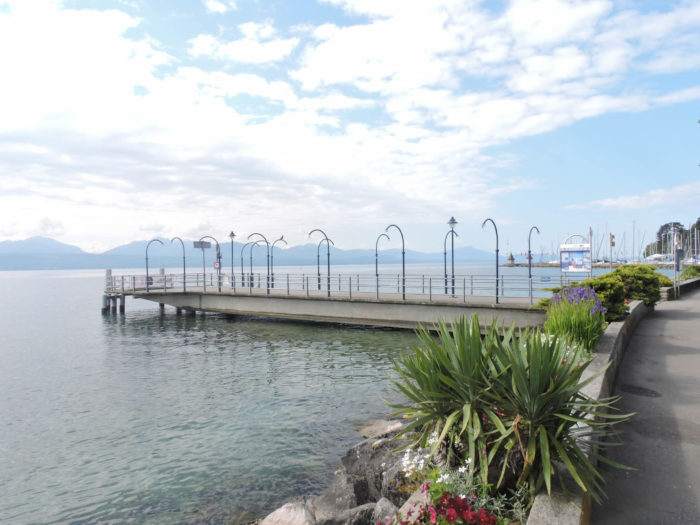 |
| During the tumult of the First World War, Stravinsky, like a pilgrim of inspiration, took up residence in Switzerland, letting himself be carried away by the enchanted shores of Montreux, where « The Rite of Spring » sprouted, as well as in Morges, the birthplace of the captivating « The Soldier’s Tale. » A composer seeking harmony in a world engulfed in chaos. At the end of the quay bearing his name, stands majestically the Castle of Morges, a fortified relic from the 13th century whose ramparts, witnesses of a tumultuous past, have given way to a cantonal arsenal since 1803. |
 |
 |
| The Via Jacobi, like a wanderer in search of truth, averts its gaze from the city, populated by 16,000 souls, and from Grand Morges, home to some 50,000 souls. After skirting the castle, it escapes into the enchanting setting of the park, along the Henryk Opienski Avenue, weaving its golden web with each step. |
 |
 |
| At the edge of the park, the avenue is carried away by the soothing murmur of the waters of the Morges River. A melodious echo, a hymn to nature flowing gently. |
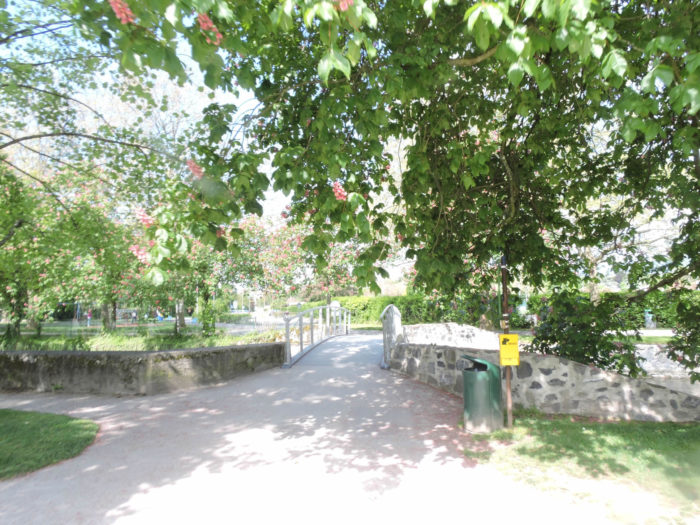 |
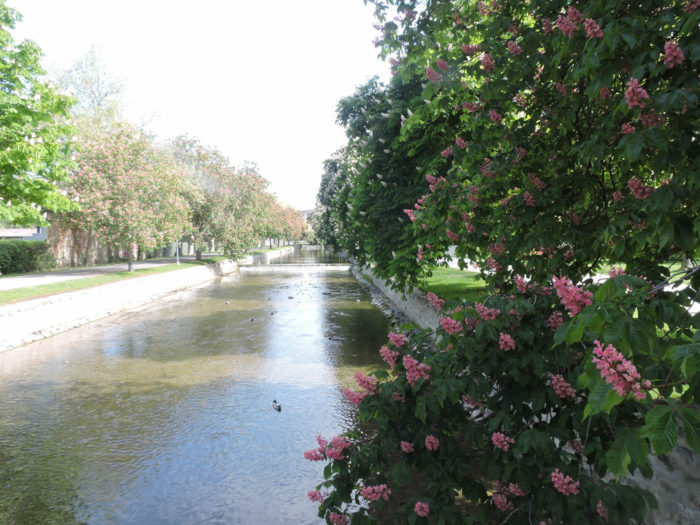 |
| Then, like a less enchanting stroll, the Via Jacobi winds its way through an area with many faces, sometimes brushing against parking lots, sometimes caressing the lake shores, punctuated here and there by modest marinas, until it merges into the horizon. |
 |
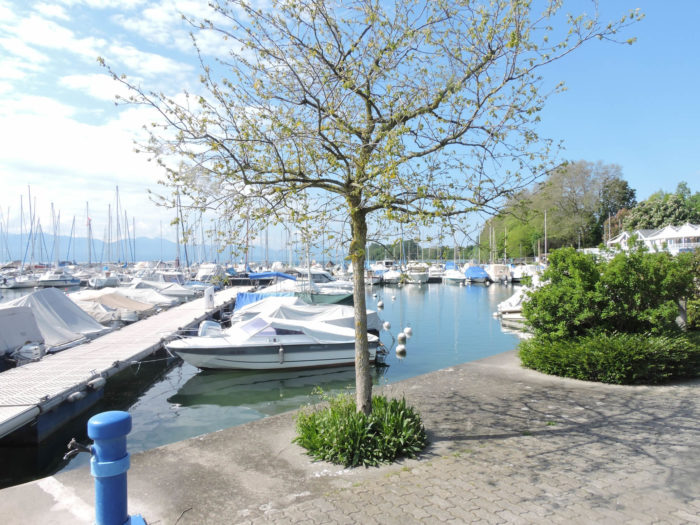 |
| Let us now imagine ourselves at the threshold of budding spring, when delicate leaves begin to unfold, enveloping the landscape in an aura of renewal.
At the city gates, a discreet path reveals itself, winding behind the cemetery, following the meanders of the lake through a woodland where beech trees flourish, tracing the mysterious Trout Path. On this Sunday, the sun shines, and the crowd pours onto the path, like a procession towards bliss. |
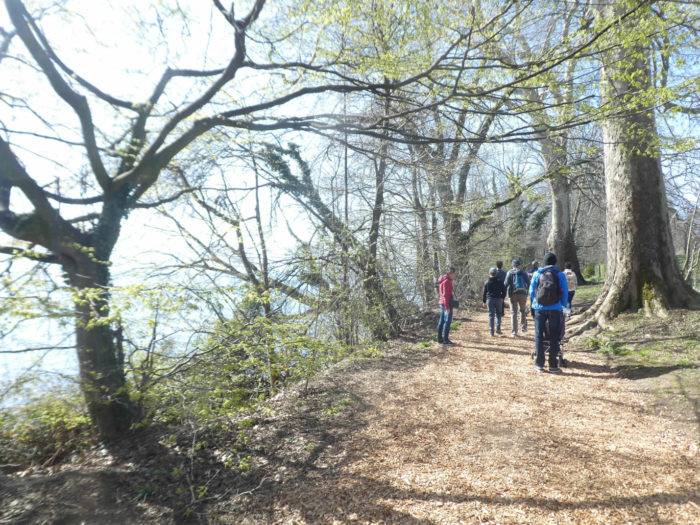 |
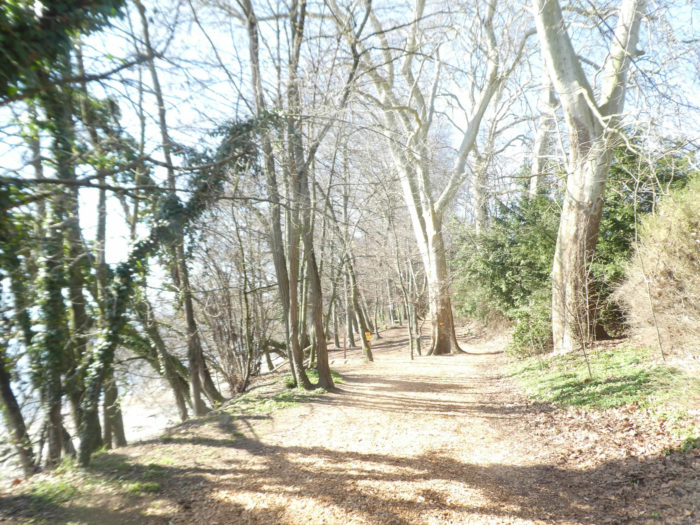 |
| At times, the path veers away from the foliage to nestle along sandy shores. The view stretches as far as the eye can see, across the lake, into France, like a painting unfolding before your astonished eyes. |
 |
 |
| Further along, a stop at a shooting range recalls a bygone era when the echo of rifles vied with the clamor of nature. Today, barbecues have replaced weapons, offering their savory incantation to the Sunday god. |
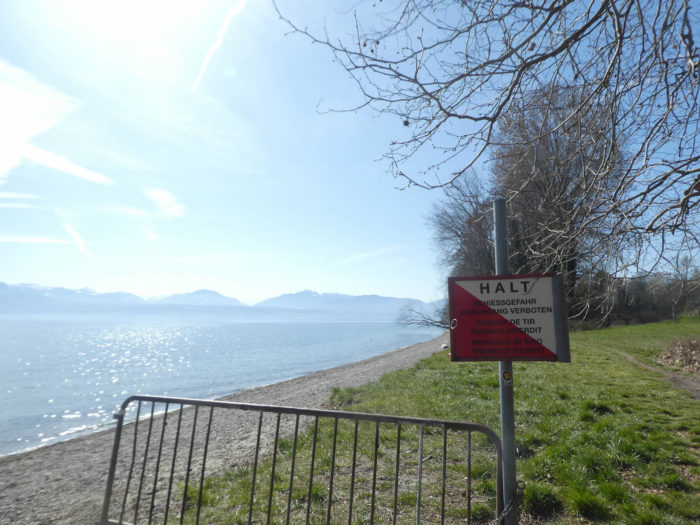 |
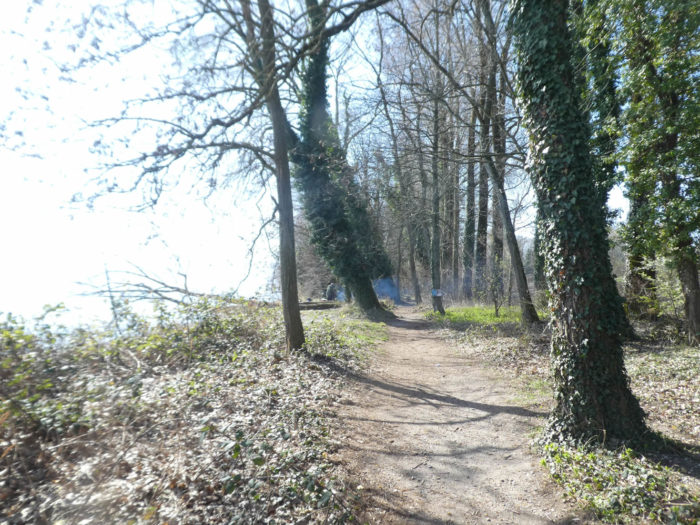 |
| Under the conspiratorial foliage, the atmosphere becomes enchanting, almost sensual. Trees lean with a graceful touch, as if to skim the shimmering waters with their leaves. |
 |
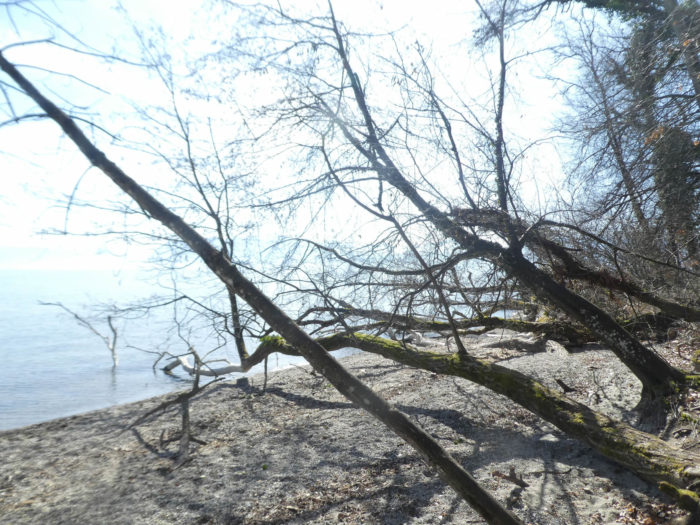 |
| A little further on, the path skirts the lake until it reaches the Morges diving sanctuary, where it veers away from the lake waters. At harvest time, a fishmonger offers treasures of pike and perch, a temptation for the traveler eager for culinary discoveries. |
 |
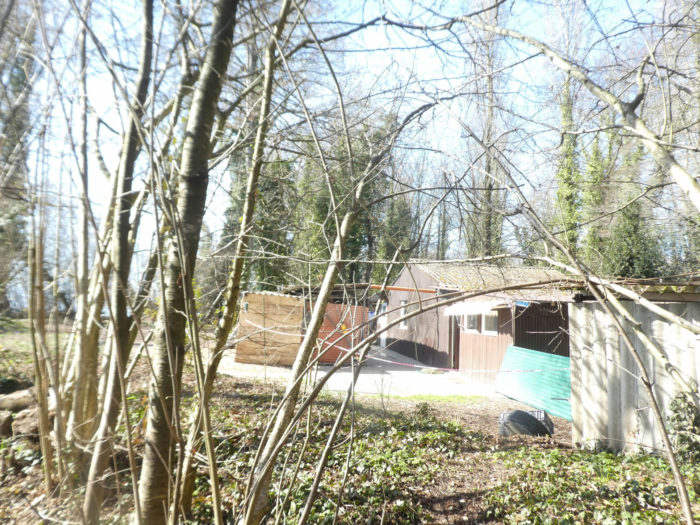 |
| A community of herons has established itself masterfully in the heights of the beeches, like silent sentinels watching over aquatic mysteries. Perhaps, in their avian wisdom, they also frequent the fishmonger’s stall, feasting on the lake’s offerings. |
 |
 |
| Yet, the lake harbors elusive corners, secret marshes that evade prying eyes. The Via Jacobi, a wise travel companion, simply follows its course towards a bridge over the Boiron River, lightly touching the unknown with the tips of its toes. |
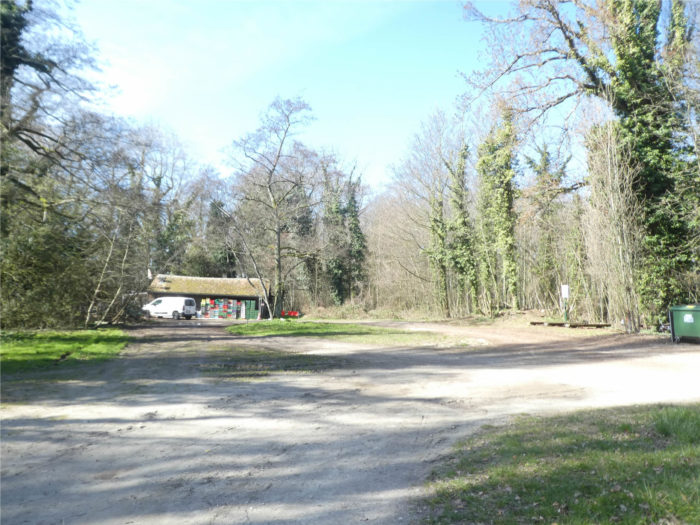 |
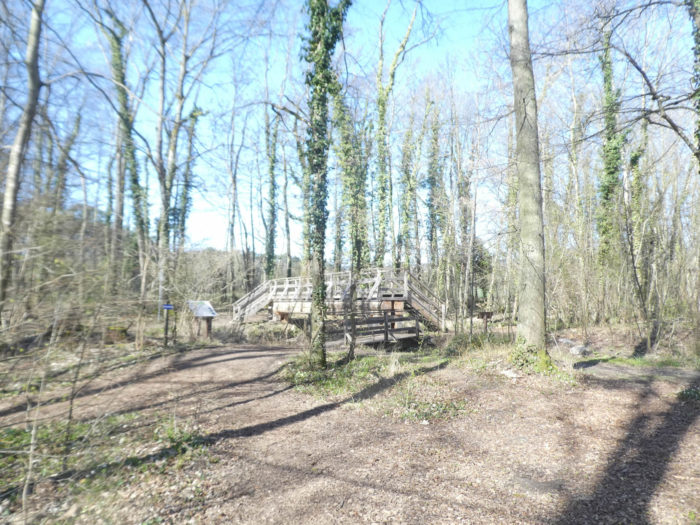 |
| It does not cross this bridge, preferring to follow the peaceful waters of the river, which merge into the lake’s embrace. |
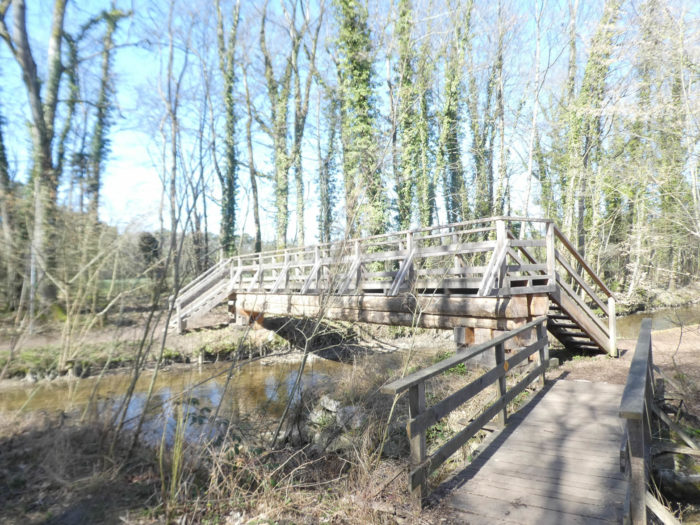 |
 |
| It then ascends the course of the Boiron until it slips under the Swiss road, this vital artery connecting Lausanne to Geneva. During storms, the tumultuous waters threaten to submerge the paths, inviting the traveler to a fleeting dance with the unleashed elements. |
 |
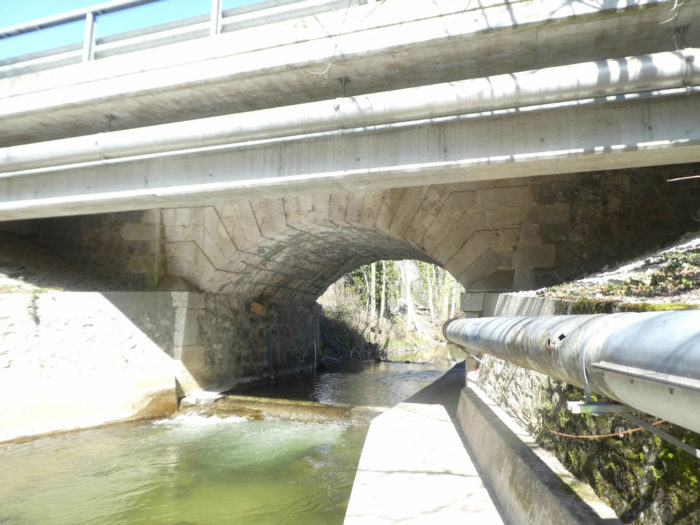 |
| On the other side of this road, a dirt path caresses the banks of the Boiron, revealing to the enchanted gaze the orchards and Sunday gardens. Here, bees buzz in tranquility, jealously guarding their sweet kingdom. |
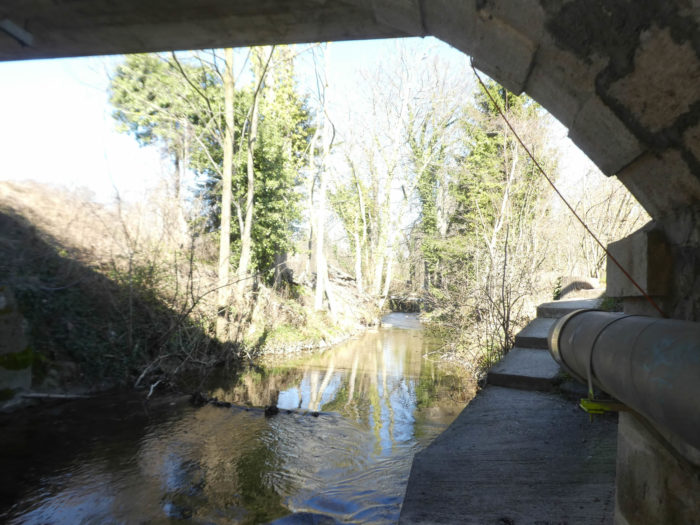 |
 |
| But soon, the Via Jacobi returns to the riverbed, inviting the walker to a brief ascent towards a hill, a prelude to a descent towards the murmuring waters. It is then necessary to remain vigilant, for a new bridge spans the river, marking the way to Santiago. A crucial choice between the bucolic tranquility of the Via Jacobi 3 and the customary adventure of the Via Jacobi 4, where each step becomes a prayer. You can go on Via Jacobi 3 and find St Prex further ahead. It’s half an hour longer. The path is more bucolic as it follows the river for a long time, but further on, the path indications are deficient, and there is a risk of getting lost. |
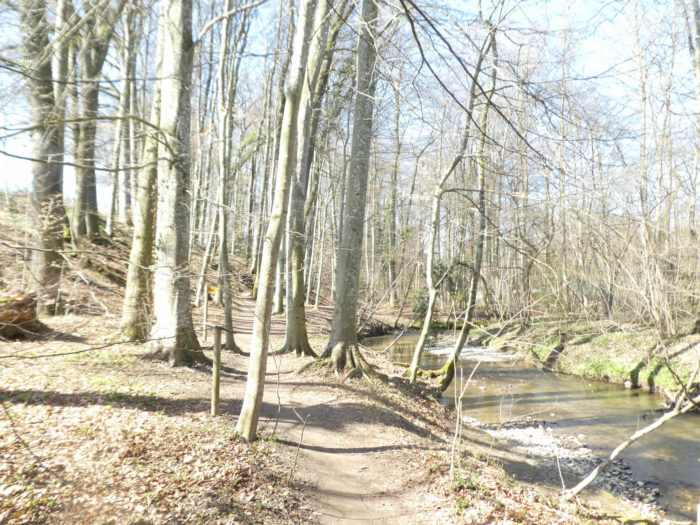 |
 |
| On Via Jacobi 4, the landscape transforms, offering the wanderer the only significant slope of the day. A wooden staircase, like a promontory to the unknown, joins the railway line, an ephemeral testimony to an endless journey. |
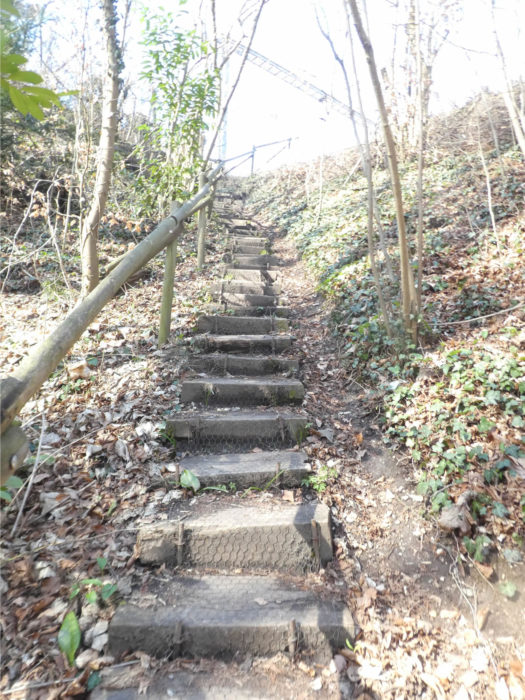 |
 |
Section 5: The crossing of St Prex
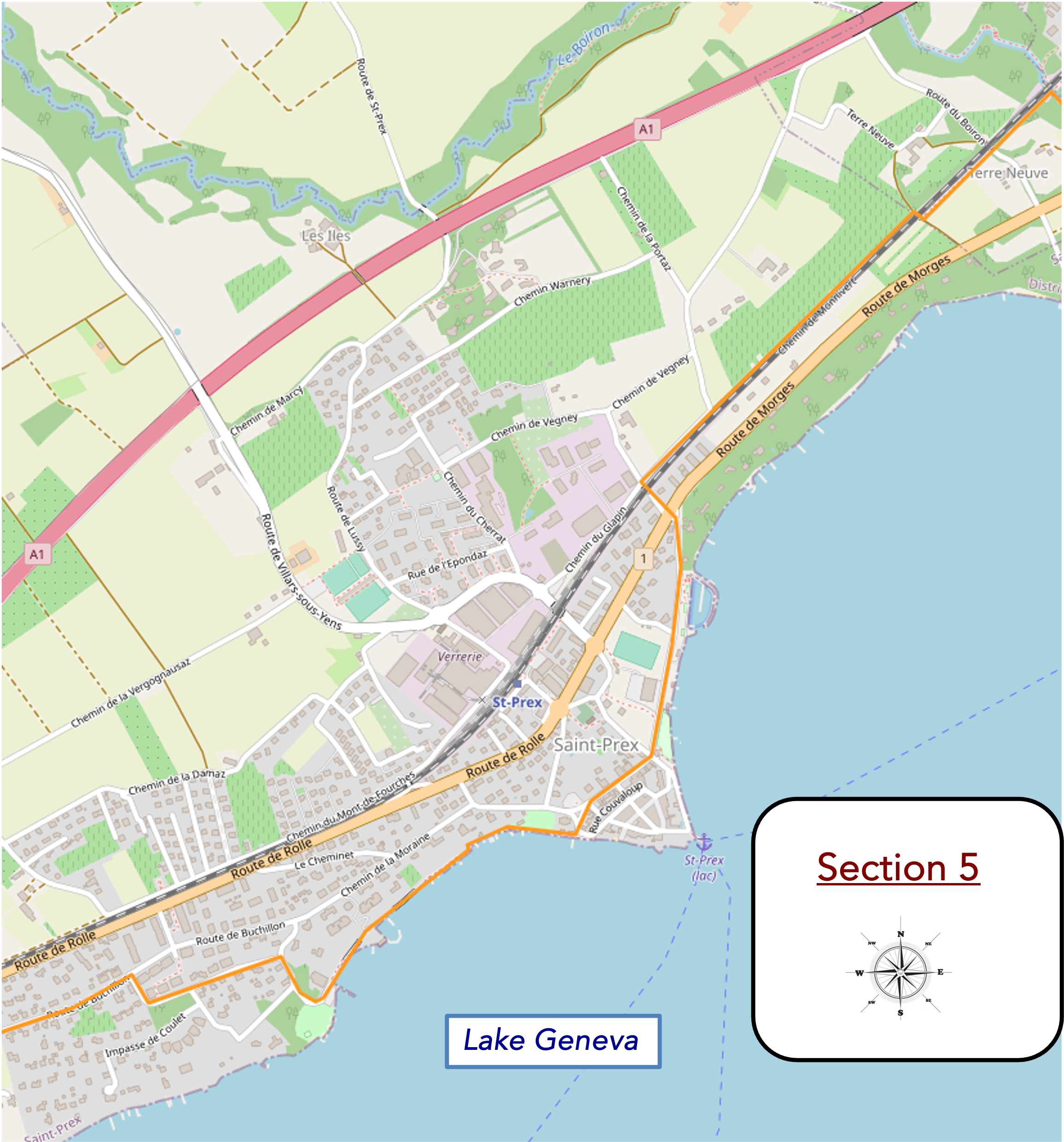
Overview of the route’s challenges : a journey without any challenges.

| Where the trail leaves the benevolent shade of the woods to emerge near the Lausanne-Geneva rails, some murmur, disillusioned: « You promised us bursts of happiness, but what felicity is found in walking alongside train tracks? » Let these restless souls be reassured. This portion of our journey, though juxtaposed with the roar of steel, will be brief today. Later, near Geneva, the incessant ballet of convoys will offer a regular spectacle, a train emerging every ten minutes to slice through the landscape. |
 |
 |
| The path, sometimes dressed in fresh grass, sometimes in humble earth, dances with the railway, crossing it from side to side in an embrace between peaceful vineyards and open fields. In the parallel pursuit of a train, there is the promise of flat ground, facilitating the progression of your steps. |
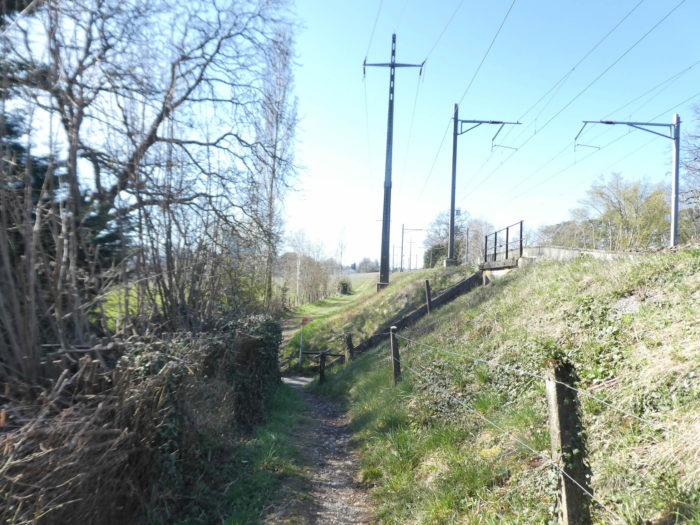 |
 |
| The Via Jacobi unfolds, linear and taciturn, in this section where nothing seems to disturb the tranquility. Further on, packed earth gives way to asphalt, a subtle transition underfoot. |
 |
 |
| Approaching St Prex, the path ventures through an area where industry begins to mark the landscape, yet it does not head towards the heart of this town of 5,600 souls, choosing instead to cross the rails that separate worlds. |
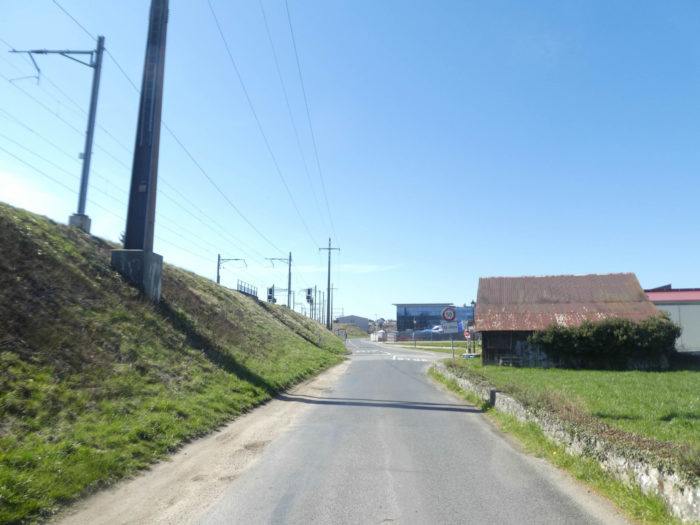 |
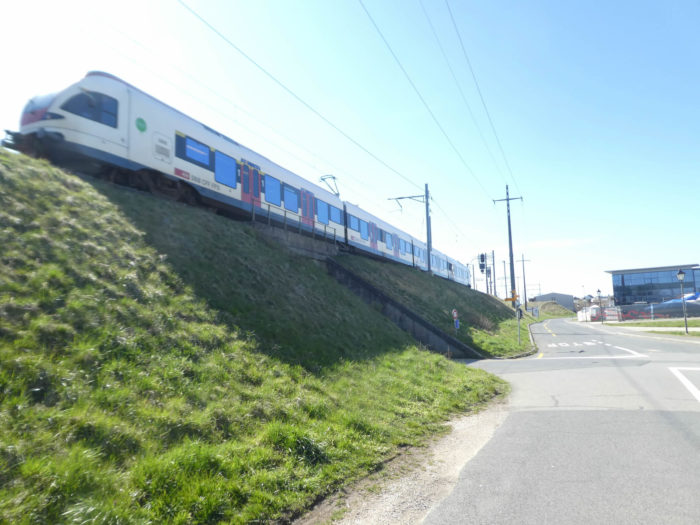 |
| Then, having crossed the Swiss Route, your path descends towards the lake, reaching the Taillecou port, where the waters open before you, free and inviting. |
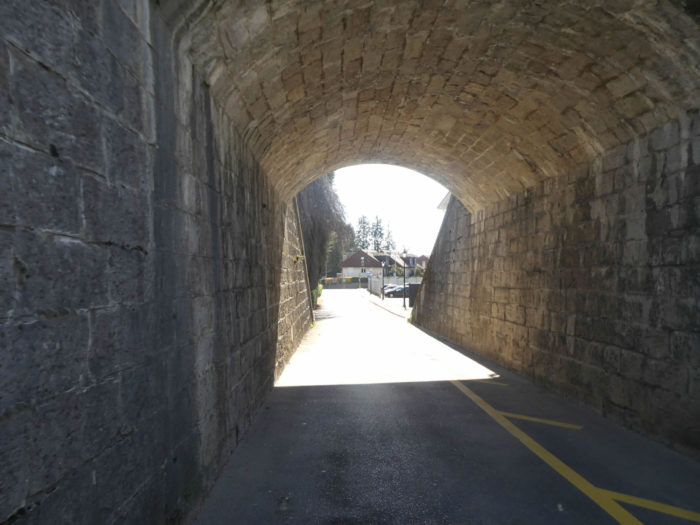 |
 |
| The journey, gliding over the port with a discreet majesty, leads to the old town of St Prex, whose ancient charm whispers tales of bygone eras. |
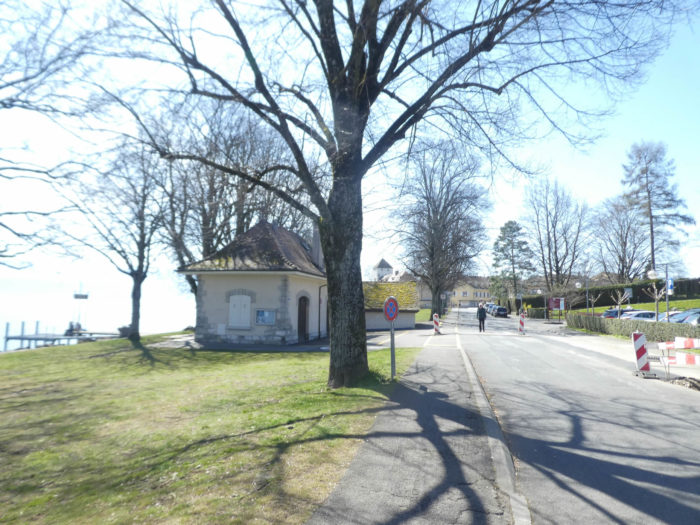 |
 |
| In this frozen moment in time, few ramparts still stand, but the crenellated clock tower gate, a jewel from the early 16th century, remains, watching over a city vibrant with life and history. |
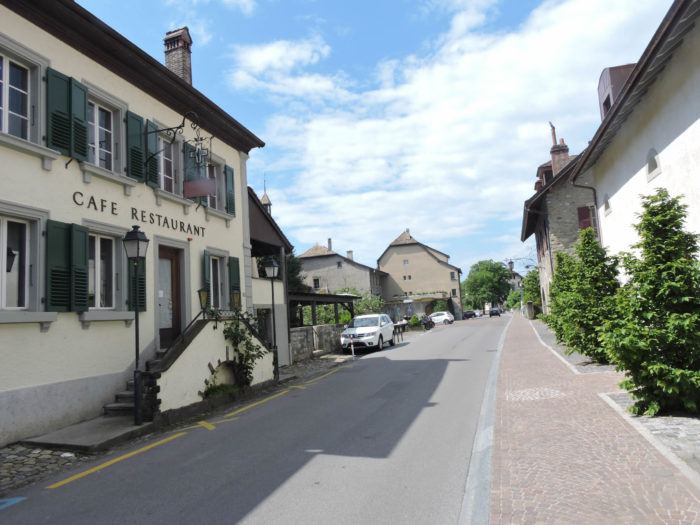 |
 |
| Moving away from the old town, the Via Jacobi descends back towards the embrace of the lake, where the jetties, like promises of escape, stretch towards the horizon. Here, perhaps, a complicit swan will wink at you mischievously. |
 |
 |
| The route then follows the shoreline, inviting you to savor once more the soothing caress of the lake. |
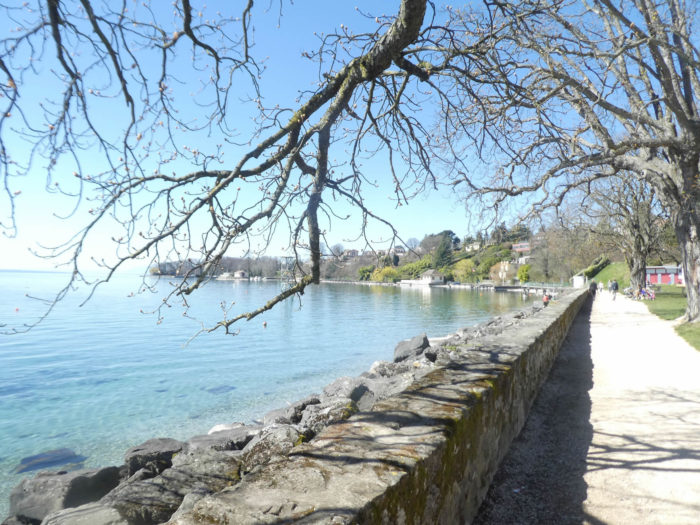 |
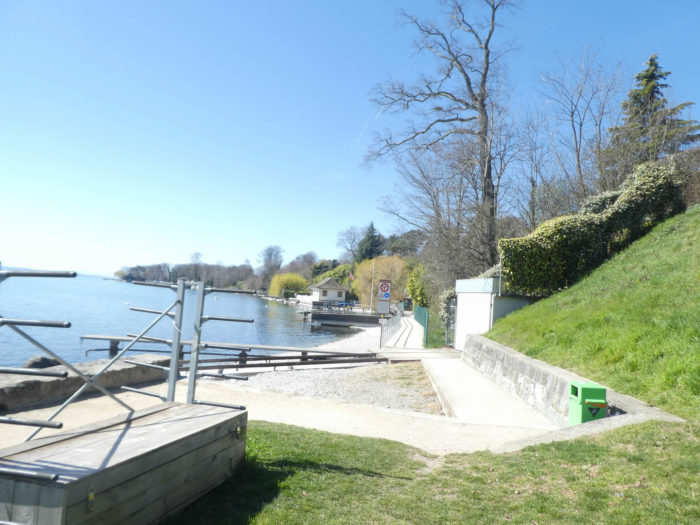 |
| A delightful path, sometimes raised on stilts, winds between private residences, commanding the lake with natural elegance. This passage could very well be the most enchanting of your journey. |
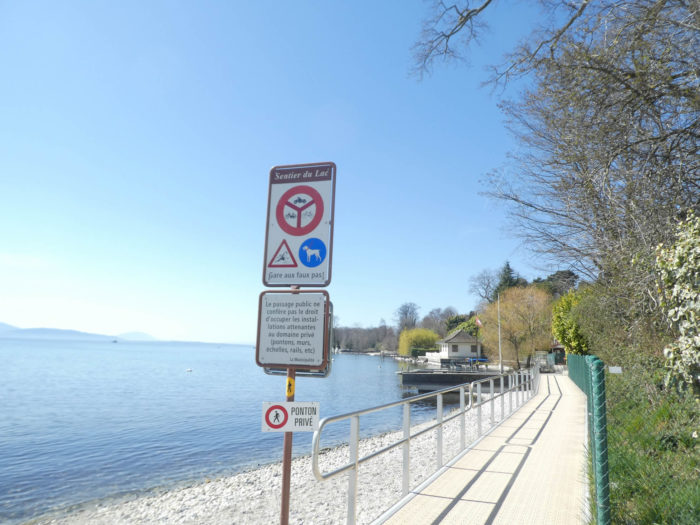 |
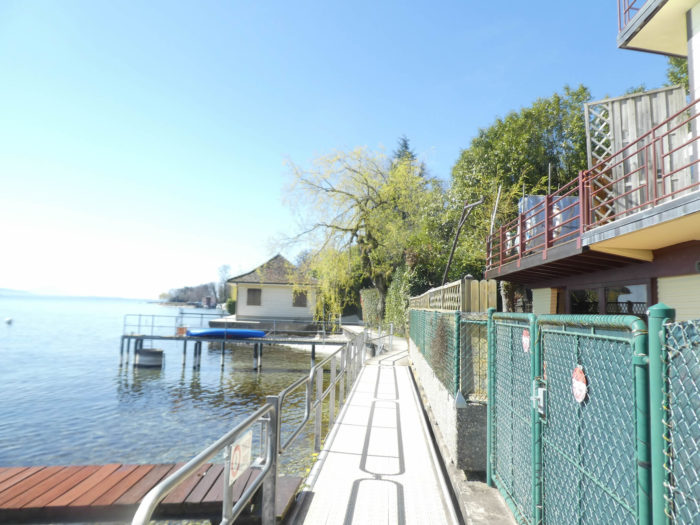 |
| Within this oasis of tranquility, lakeside property owners have forged agreements with the municipality for ages, in a country where the law hardly cherishes public passages along lakes. Here, only tradition and local policy shape a tacit agreement with legislation, allowing for this almost secret passage. |
 |
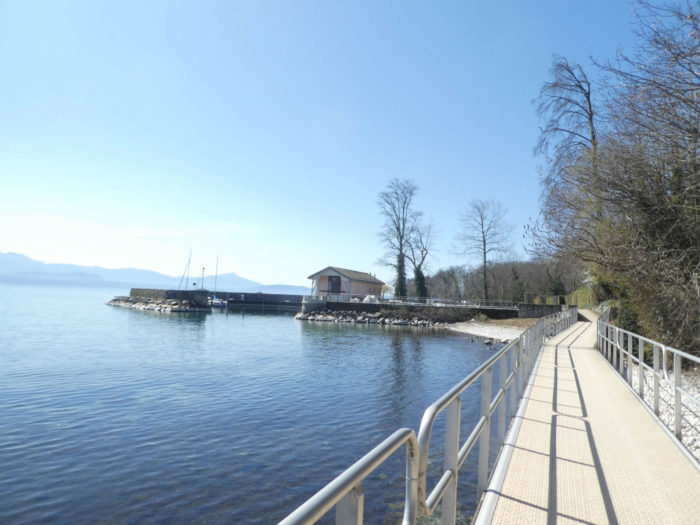 |
| The path finally unfolds to embrace the Coulet beach, concluding your communion with the lake on this note of sand and water. |
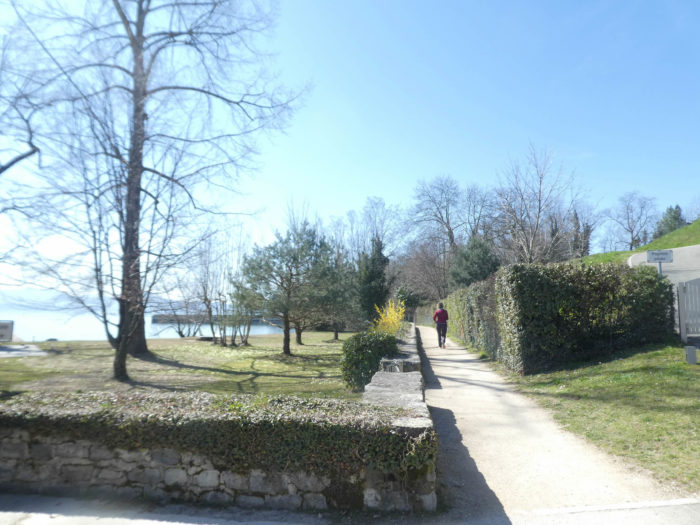 |
 |
| From the Coulet beach, your connection with the lake transforms into memory, the road ascending towards modern villa neighborhoods, where architectural splendor struggles to arouse the wanderer’s excitement, despite the occasional glimpse of the lake peeking between the constructions. |
 |
 |
Section 6 : Towards the beautiful and tumultuous Aubonne
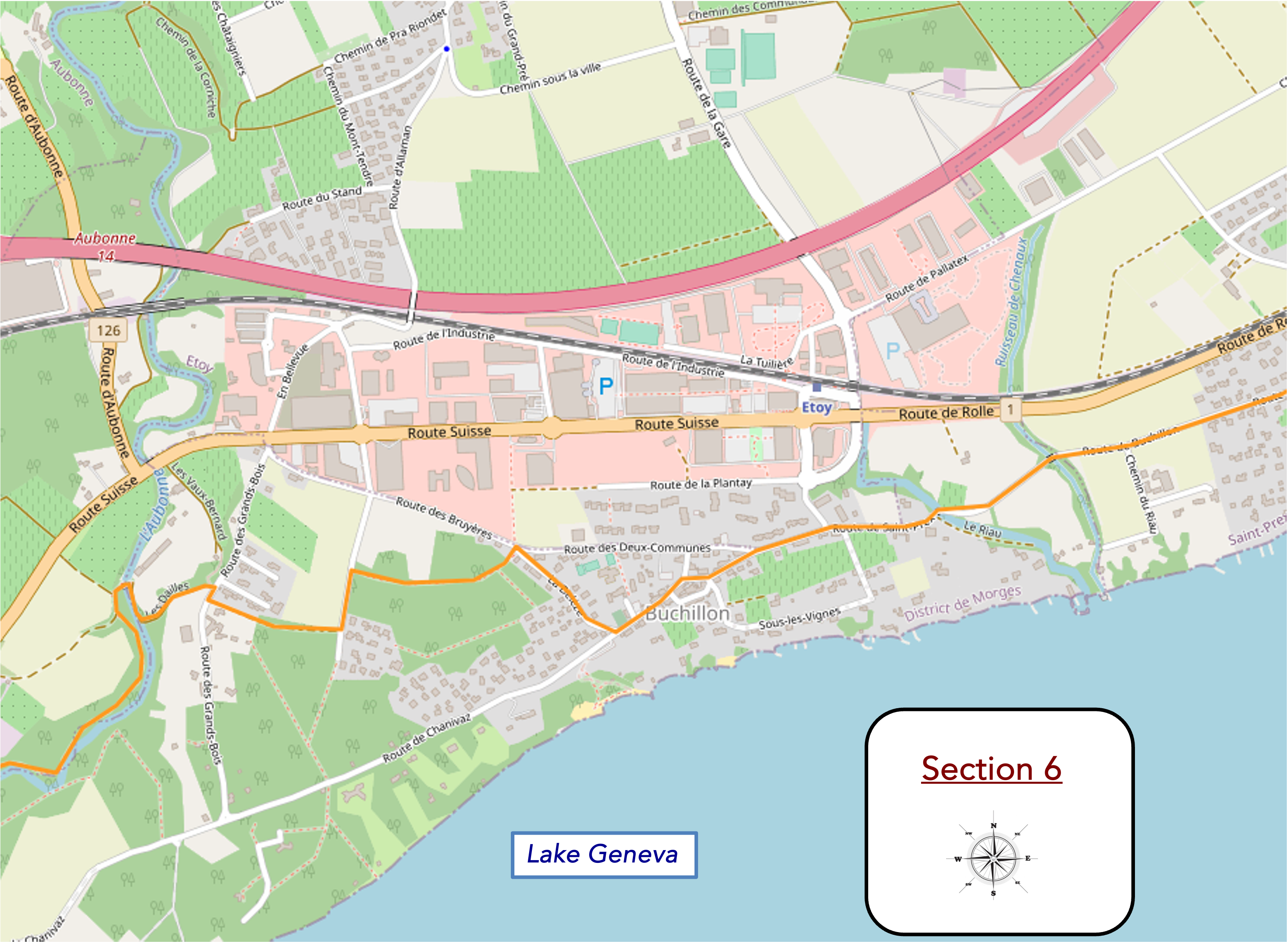
Overview of the route’s challenges : a route without any difficulty.
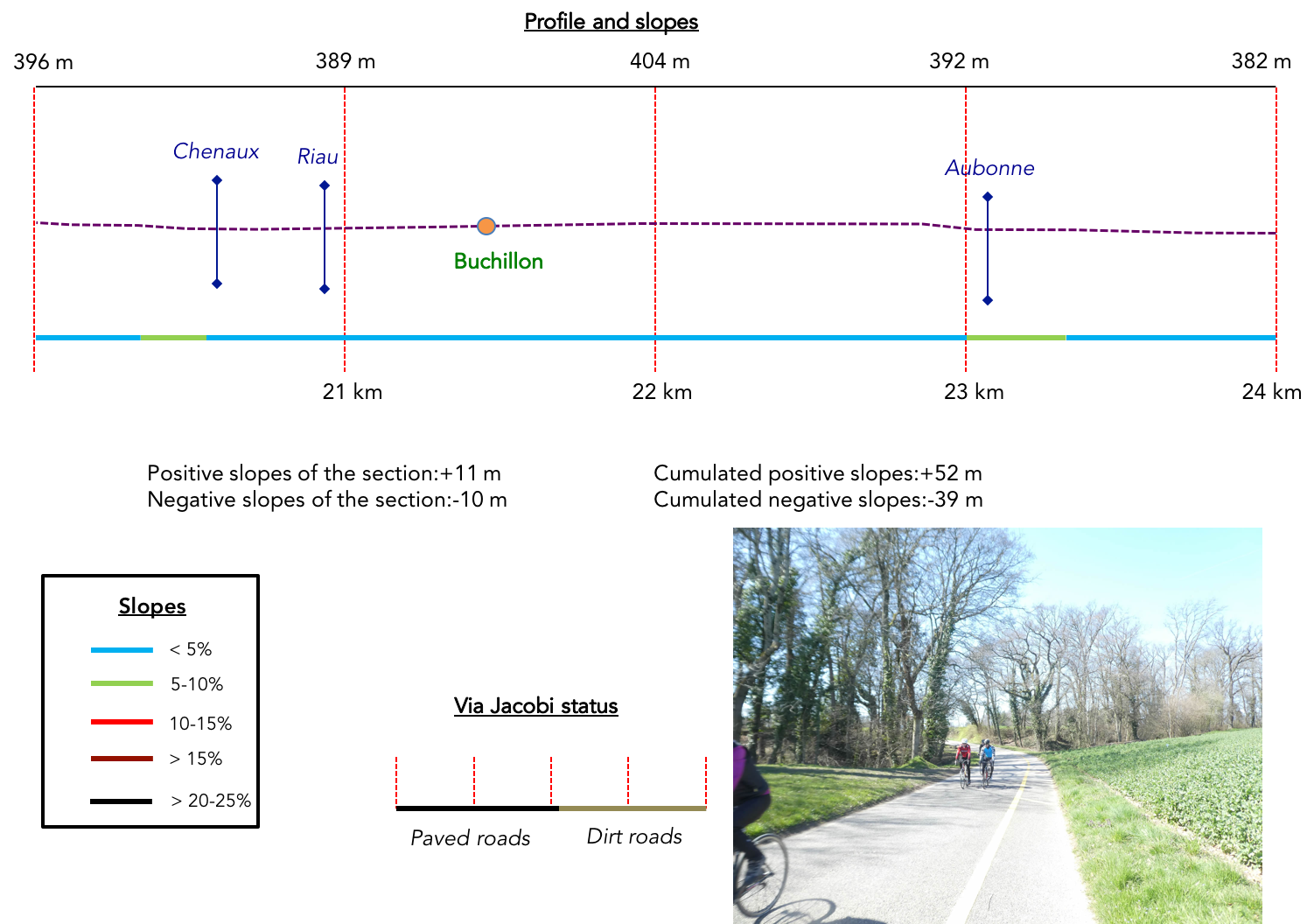
|
As the road moves away from the village, it finally ventures into the countryside, a living tableau where some farmers still resist the passage of time. The earth beneath their feet is a precious relic, its value, one can imagine, reaching dizzying heights in this region.
|
 |
 |
The road gently slopes towards a welcoming grove, where the murmur of the Chenaux stream cradles the air, before continuing towards the clear waters of the Riau stream. The road then ascends, as if caressed by a gentle breeze, to the threshold of the village of Buchillon, arousing curiosity in you for what lies ahead.
|
 |
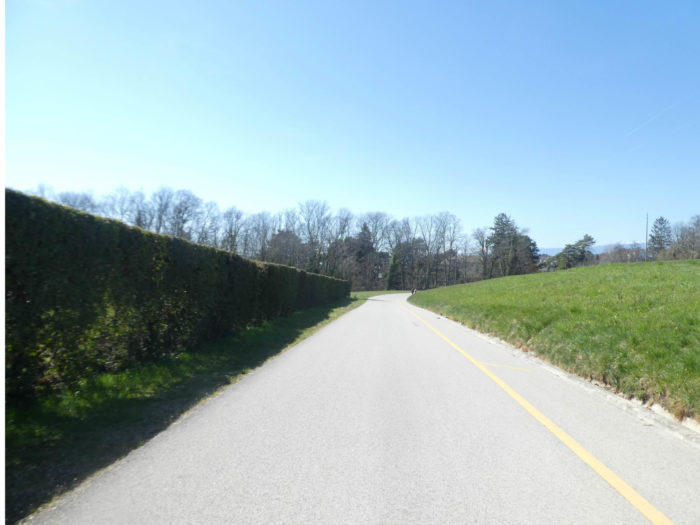 |
| The road straightens a little, often winding through vineyards that embrace the village’s slopes, as if embracing its viticultural history. |
 |
 |
| Once, this village breathed the vine, a fact immortalized by the wine press screw marking its entrance, a silent witness to a bygone era. Today, in this region where nature once dictated its laws, the vineyards give way to masterful residences, modern fortresses of a new aristocracy, among which emerge the retreats of international sports personalities, a testimony to an evolution where heritage and prestige redefine the landscape. |
 |
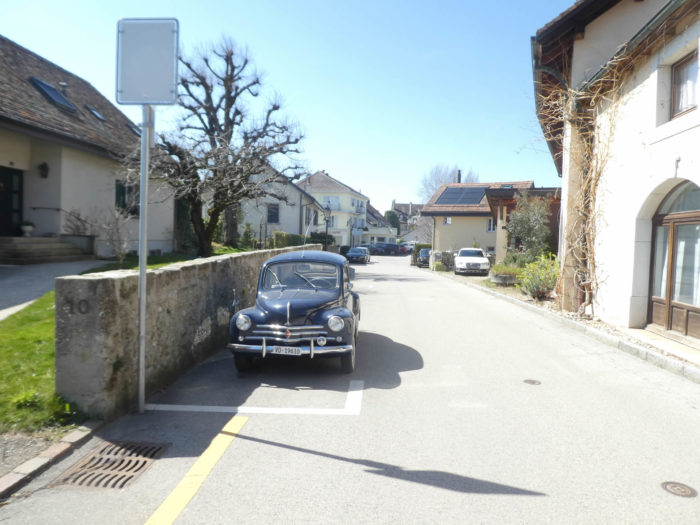 |
|
Buchillon unfolds, stretching its silhouette from the lake to the hillsides. Curiously, the path avoids the lake, an unresolved mystery suggesting that some owners, whose wealth is no secret, have preferred to keep this natural treasure to themselves. The dairy, now silent, stands like a monument to the memory of a bygone era.
|
 |
 |
| The Via Jacobi skirts the temple, revealing that you tread the ground of a Protestant land, a faithful reflection of the majority of the canton of Vaud. |
 |
 |
| Leaving the village, your journey first regains the tranquility of a path along the grove, then a stretch of asphalt, as if to remind of man’s discreet presence in this natural symphony |
 |
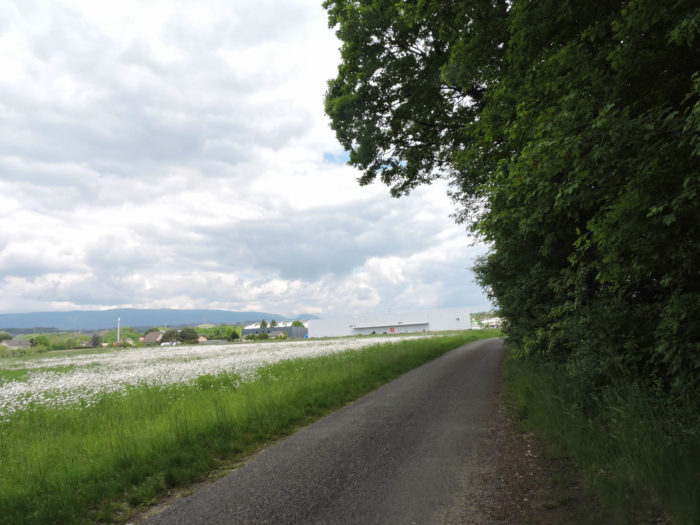 |
| And then, nature claims its rights again, guiding you through a grove alongside a commercial area, a testimony to the constant dialogue between nature and progress. |
 |
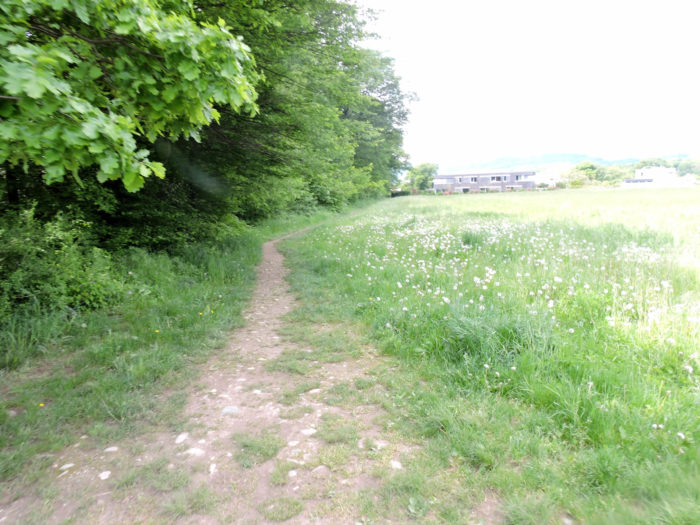 |
| Further on, the path reaches the Grands Bois, a sanctuary of conviviality cherished by the local population and a refuge for wealthy foreign souls seeking a moment of escape. |
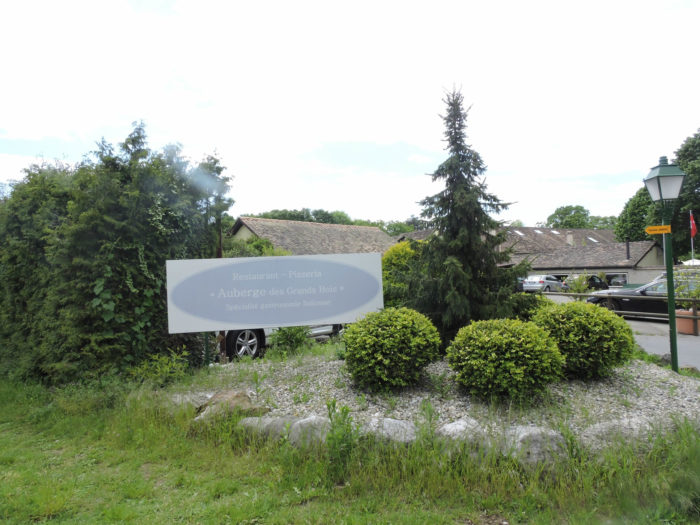 |
 |
| A modest road quickly leads you to another grove, where the waters of the Aubonne, in their tumult, sculpt the earth in their descent from the Jura mountains. |
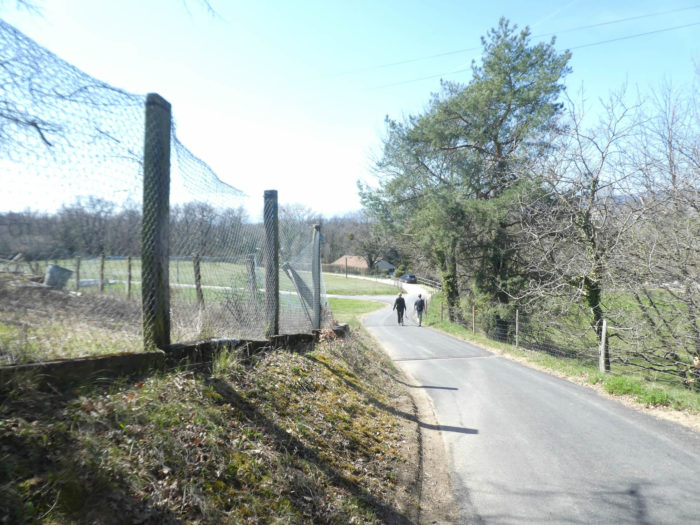 |
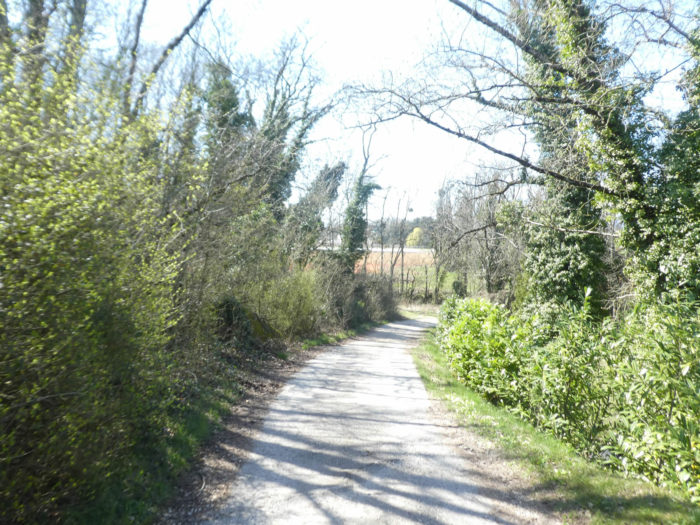 |
| Here flow the tumultuous waters of the Aubonne, a fairly large river which descends from the Jura mountains. |
 |
 |
| The Via Jacobi spans this wild river with a stone bridge, whose waters, like a cascade, sing a beautiful melody. |
 |
 |
| Once across the Aubonne, the castle of Allaman looms on the horizon, a promise of history to explore, for those tempted by old stones and indulgent stops. Yet, the river, in its bed, offers a path bordered by even more striking beauties. |
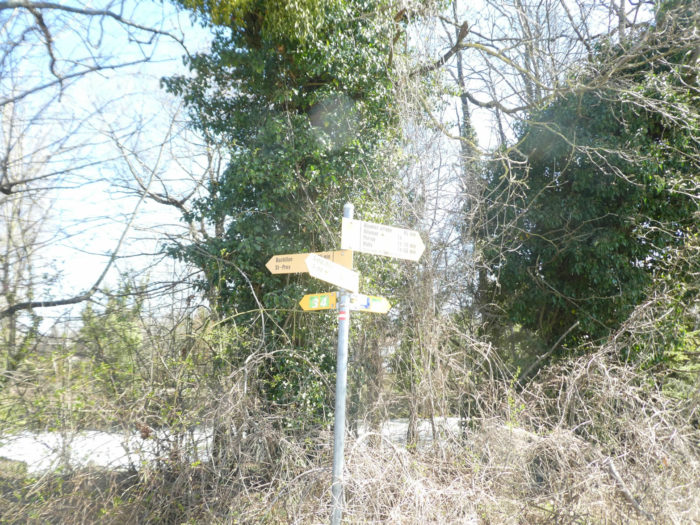 |
 |
| Soon, the path ventures again into meadows but quickly reunites with the capricious course of the Aubonne, sheltered under the foliage of grand oaks and majestic beech trees. |
 |
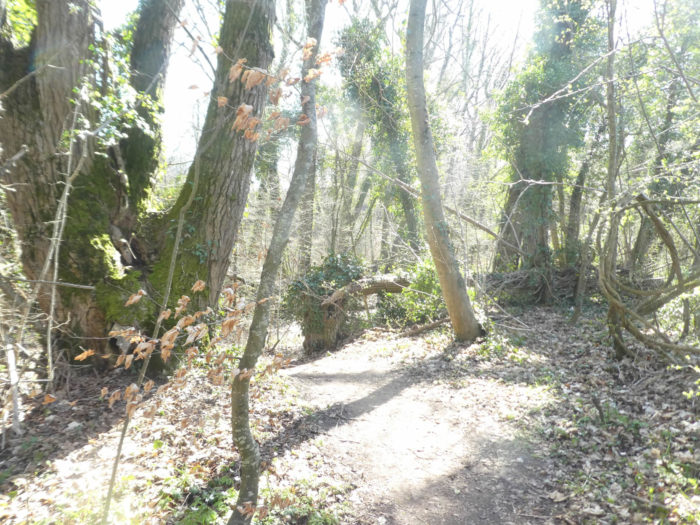 |
| On the other side of the woods, the castle of Allaman stands, overseeing a plain where vineyards, fruit trees, and vegetable crops form a living patchwork. |
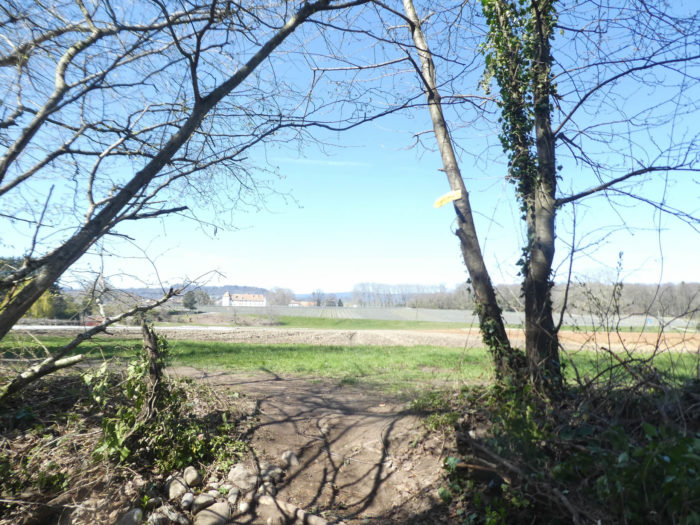 |
 |
| The path, in its embrace with the water, meanders under the refreshing canopy, offering a journey of extended happiness to its hikers. |
 |
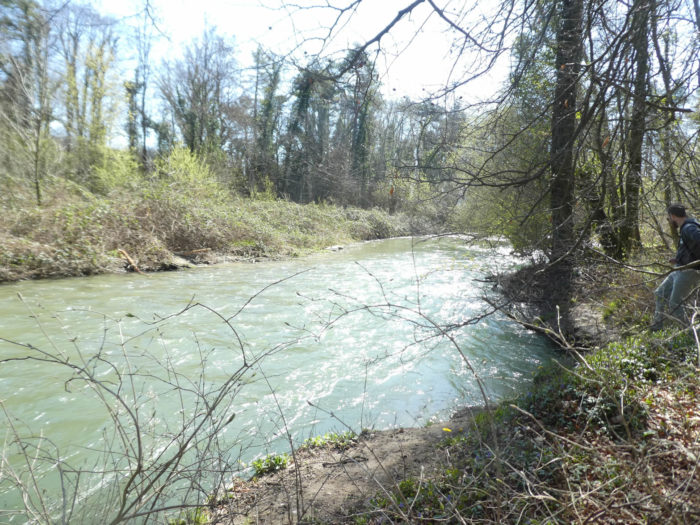 |
| Further on, when the path along the bank becomes impassable (how long?), one cannot help but think that it is to better invite you to admire the gravel pit, a testament to the perpetual interaction between man and river. |
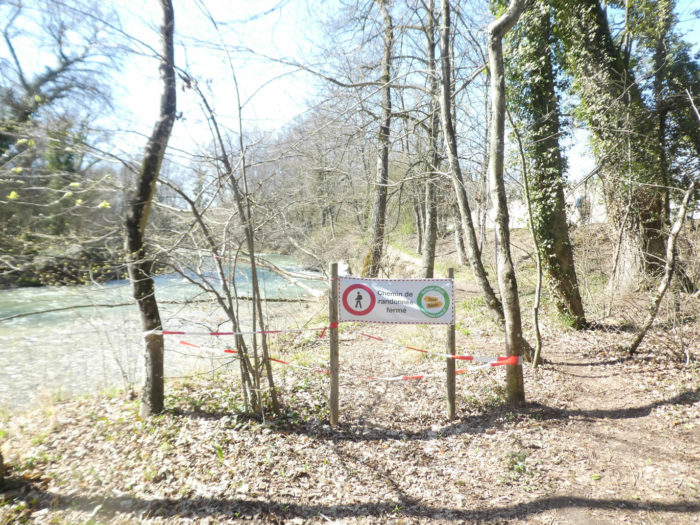 |
 |
Section 7 : A river, a bit of fishing, and vineyards
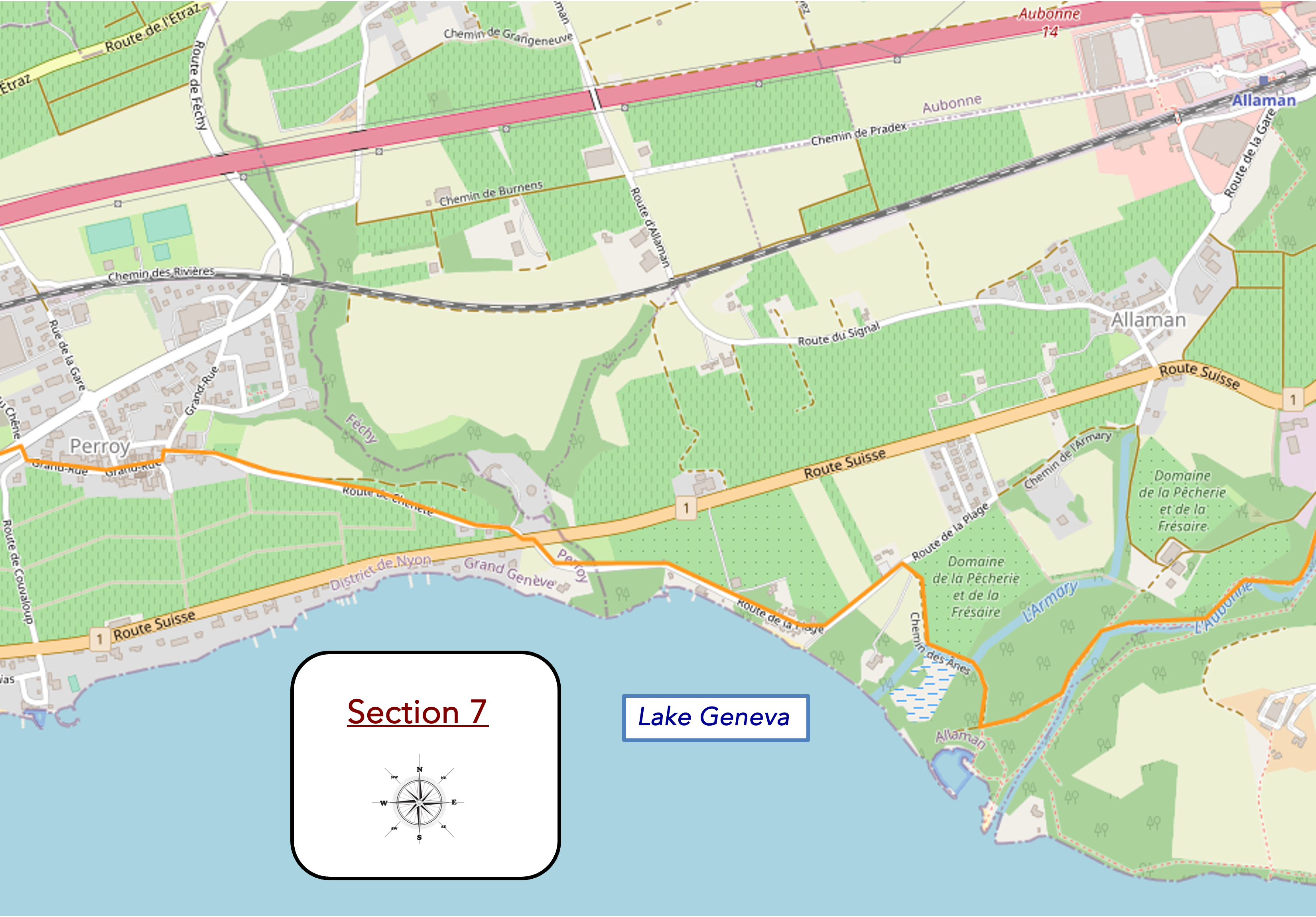
Overview of the route’s challenges : a route without any difficulty.
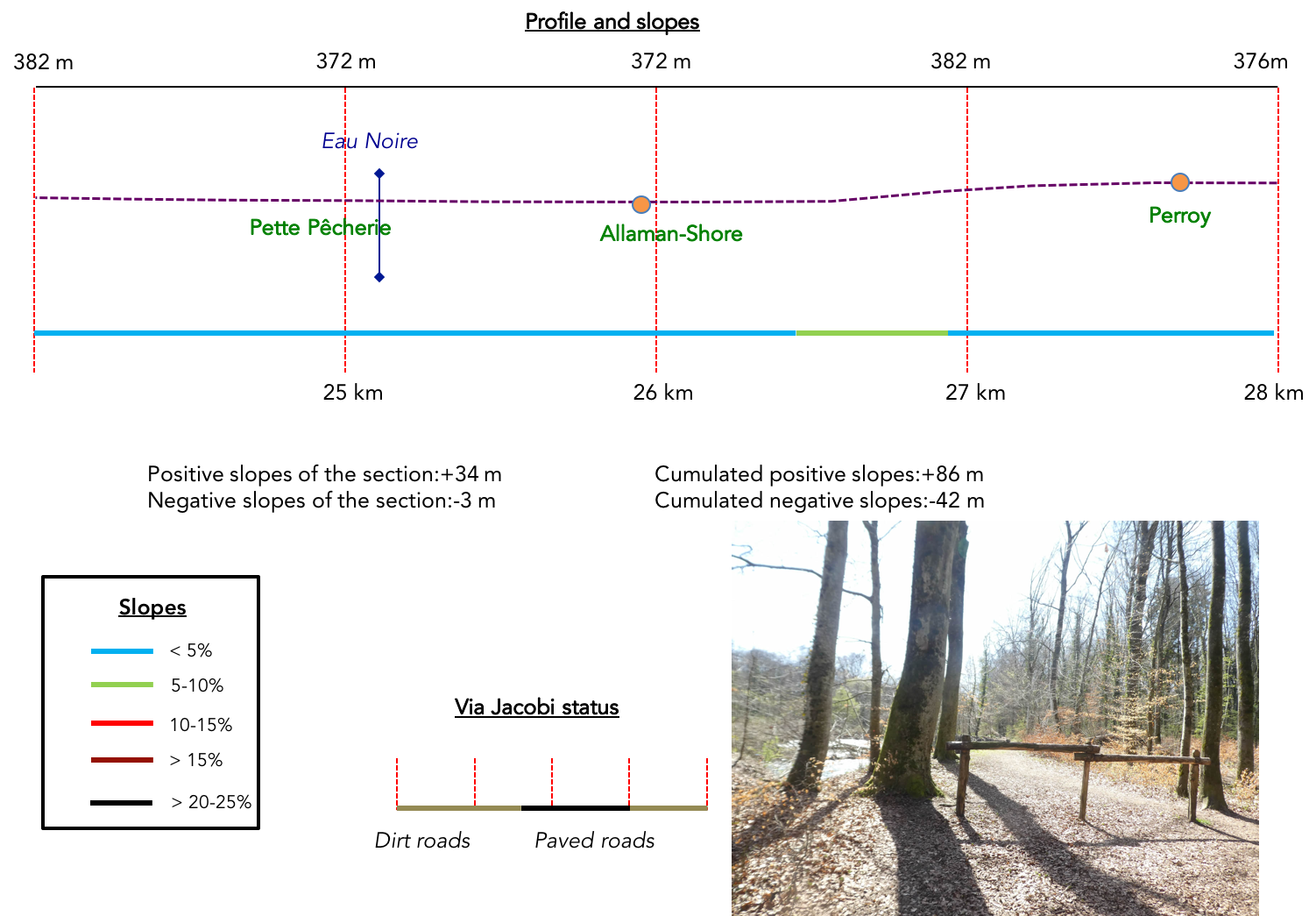
|
The Via Jacobi, like a playful dancer, begins its ballet of shadows and lights once again with the river, concealing its charms before revealing them in a new light.
|
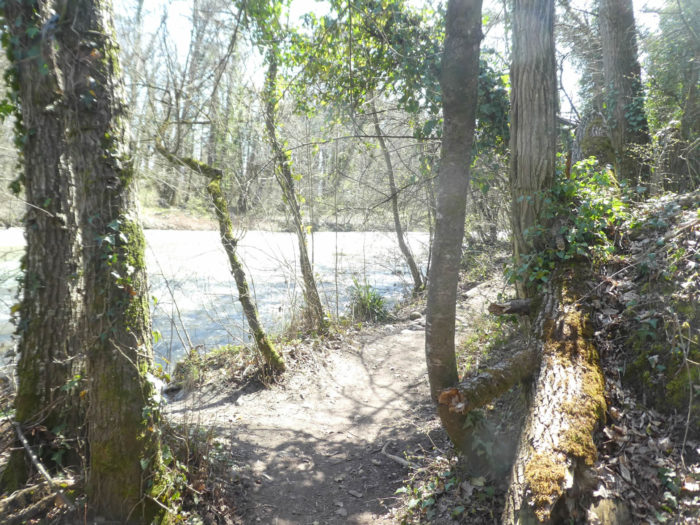 |
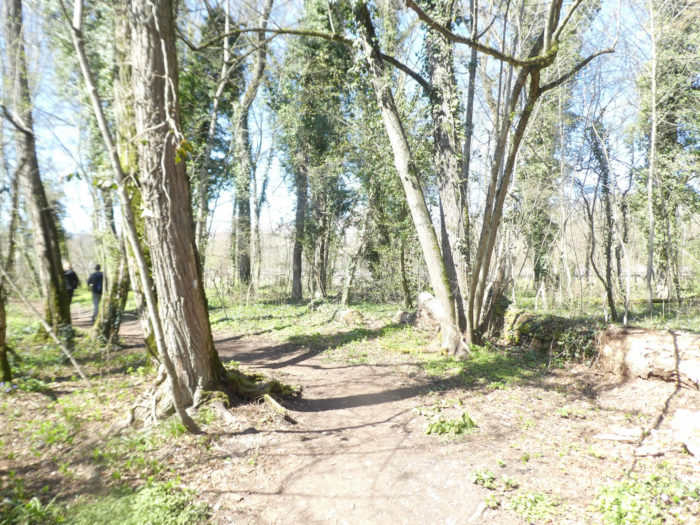 |
| Hardly after this evasion, it leads us into a vast clearing, a green haven where fruit trees stand. Here you are at the heart of the Pêcherie and Frésaire domain, where a sign, like a vigilant guardian, directs you towards the Via Jacobi 3, climbing through the domain, but it is not your route. |
 |
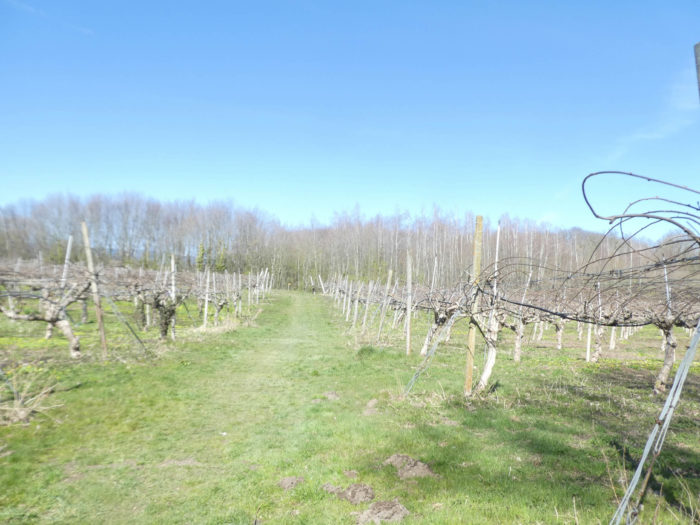 |
Via Jacobi 4, on the other hand, persists in its intimate proximity to the river, guiding you through a marshy land where the splendor of nature seizes the soul and takes one’s breath away. .
|
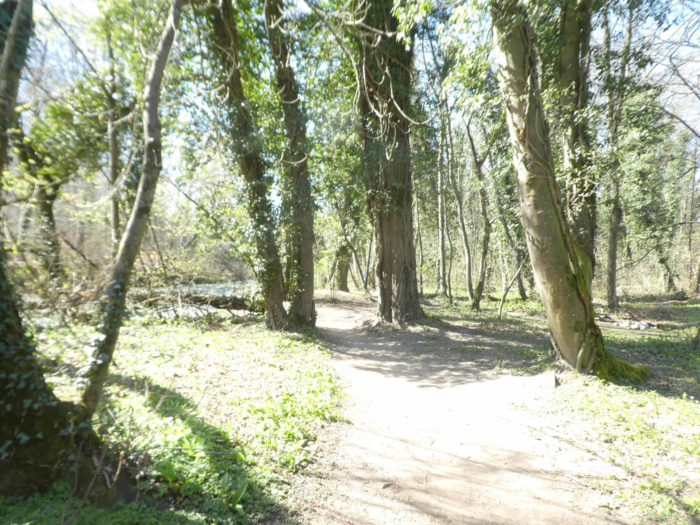 |
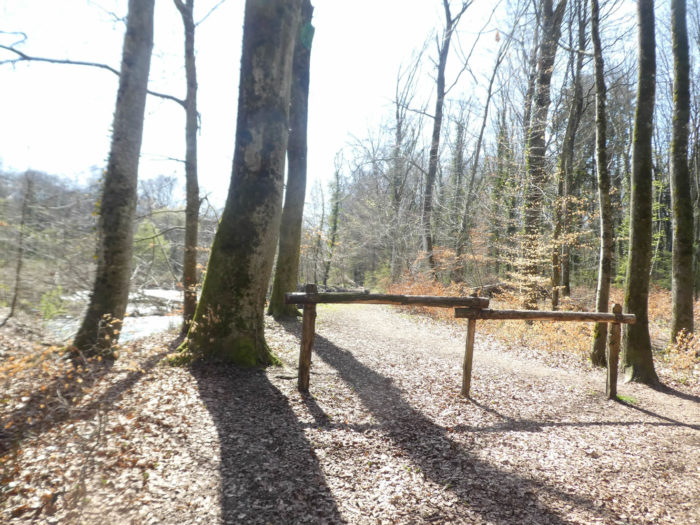 |
| In this setting, moisture and shade conspire to offer a sanctuary to wild garlic, which, in spring, covers the ground with a living carpet, testifying to its preference for watercourses. |
 |
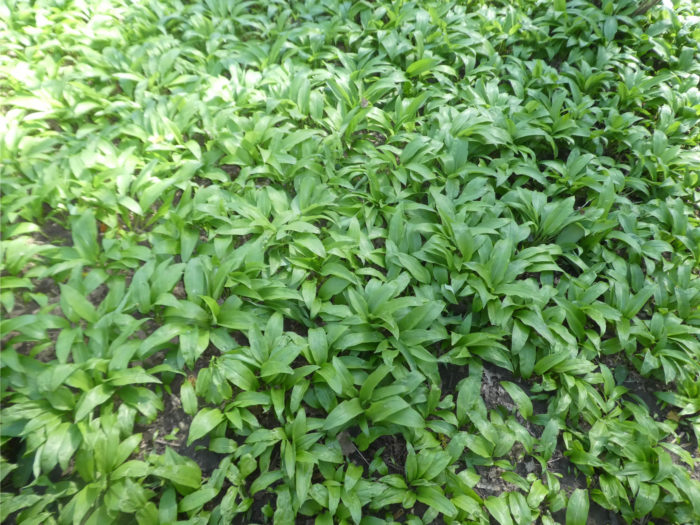 |
| Further on, the path, leaving the welcoming arms of the Aubonne, widens and emerges from the forest, revealing the other side of the Pêcherie and Frésaire domain. |
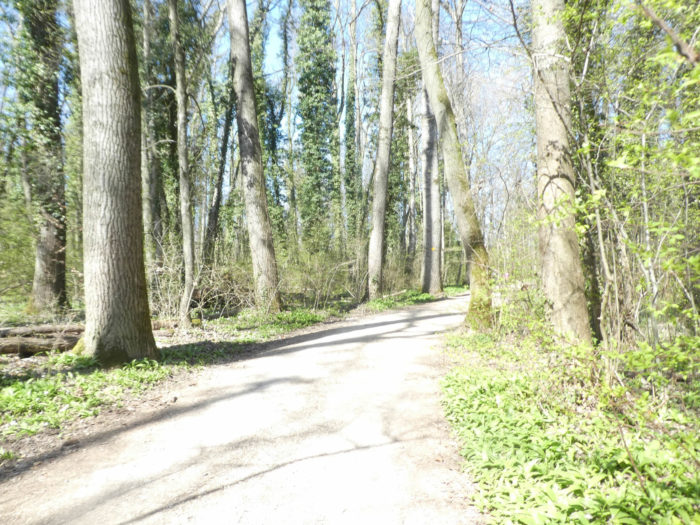 |
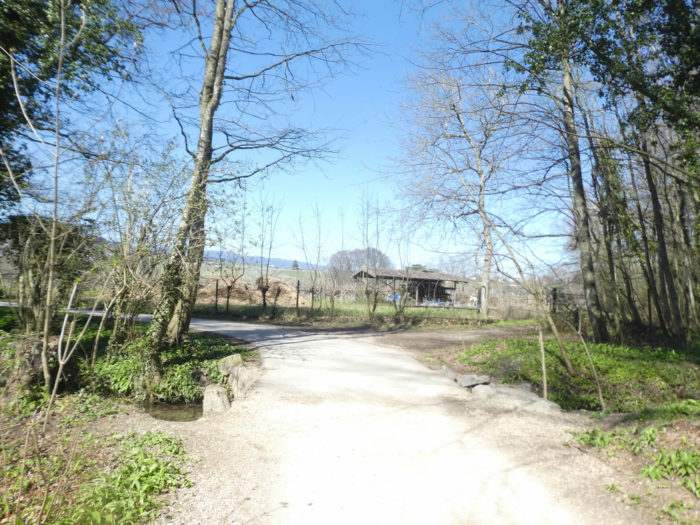 |
|
A modest road then takes over, winding along the domain, accompanied by the Armary stream, in an almost musical harmony.
|
 |
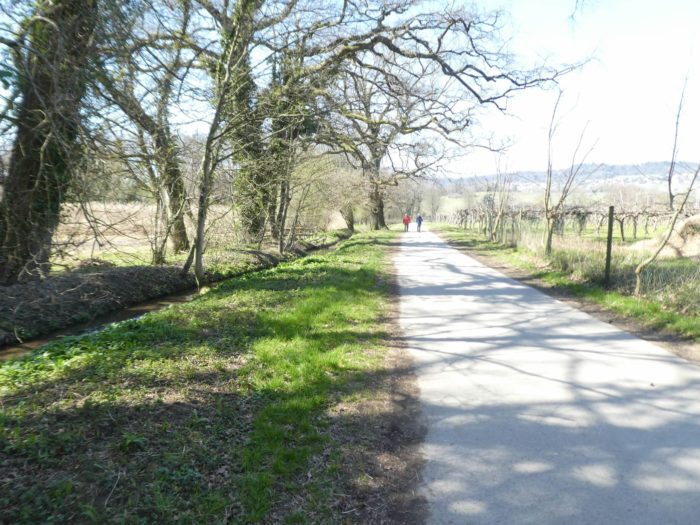 |
| You are invited to walk on « Chemin des Ânes, » which leads you towards the « Route de la Plage ». |
 |
 |
The road, heading towards the lake, at La Pêcherie, the port of Allaman, becomes the scene of excitement on weekends and during fair weather.
|
 |
 |
| Here, at the water’s edge, the road hugs the river bank. An invitation to take a break is offered to you, to savor perch fillets, gastronomic jewels of the restaurants that dot Lake Geneva. |
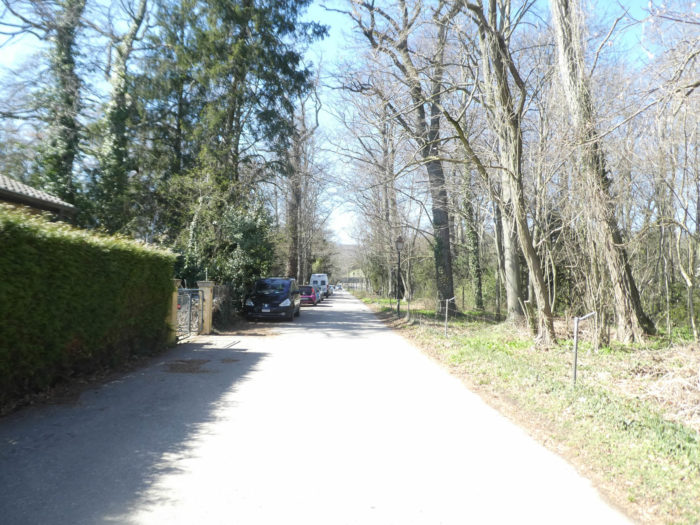 |
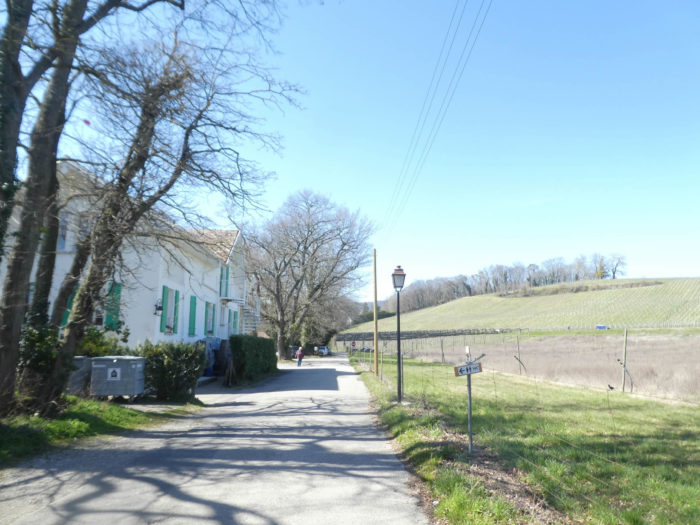 |
| At the exit of La Pêcherie, the Via Jacobi once again forsakes the caress of the shore for a dirt road winding between vineyards and fruit trees, crossing the dark waters of the Black Water. |
 |
 |
| Then, in an almost solemn gesture, the Via Jacobi joins the Swiss Route, at the gates of Rolle. |
 |
 |
| There, it dares to cross the road and ascends towards Perroy, in an ascending movement, almost celestial. |
 |
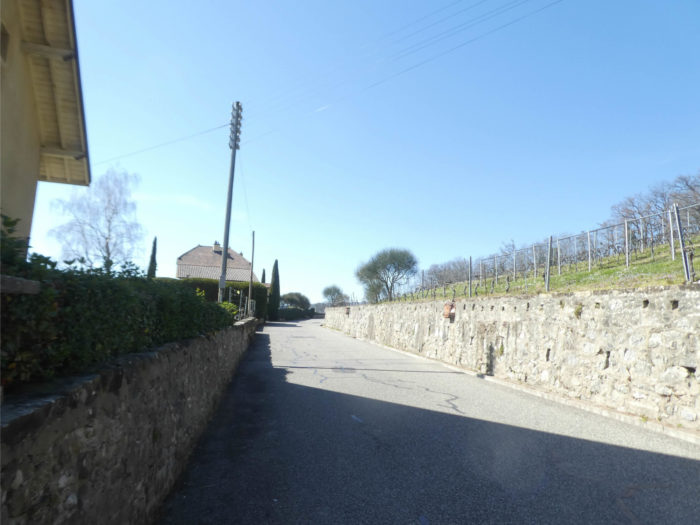 |
| The climb is through the vineyards, offering plunging views of the lake, revealing a spectacle where blue merges with green, a tableau so perfect that it becomes evident why the path could not border the lake, guarded by a procession of luxurious villas, some for more than 10 million Swiss francs. . |
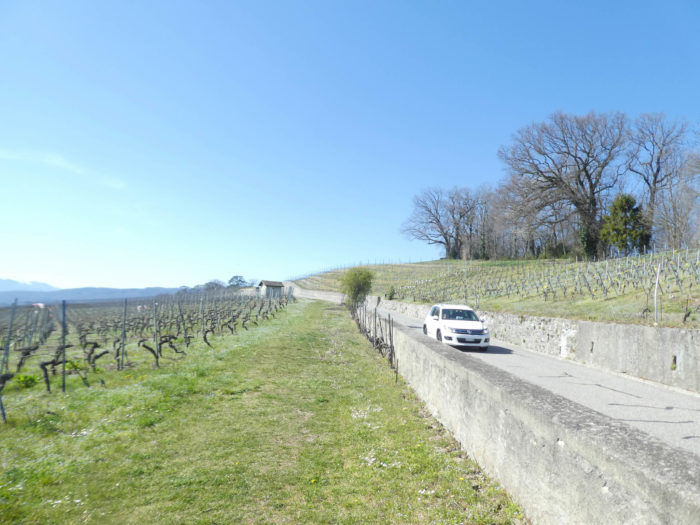 |
 |
| There was a time when signs directed walkers through the vineyards without reaching the village, but these have disappeared. Perhaps the vineyard owners grew weary of unwanted visitors? Nevertheless, the new route through Perroy only gains in charm, with the village offering an exceptional stopover. |
 |
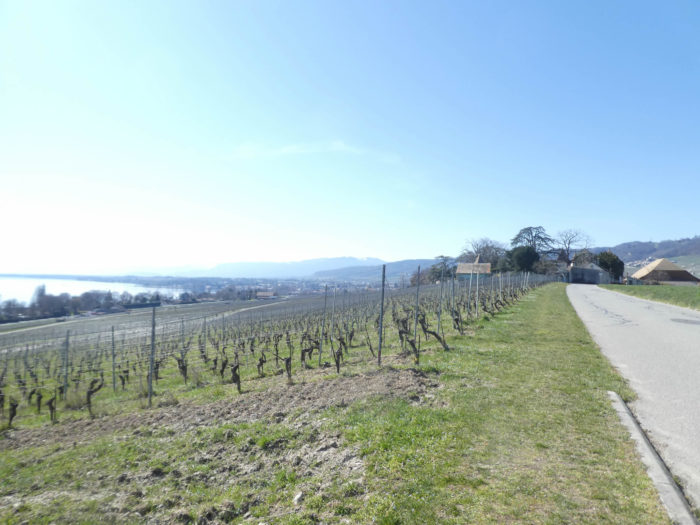 |
| At the top of this ascent, the Via Jacobi adorns itself by reaching the castle of Perroy. |
 |
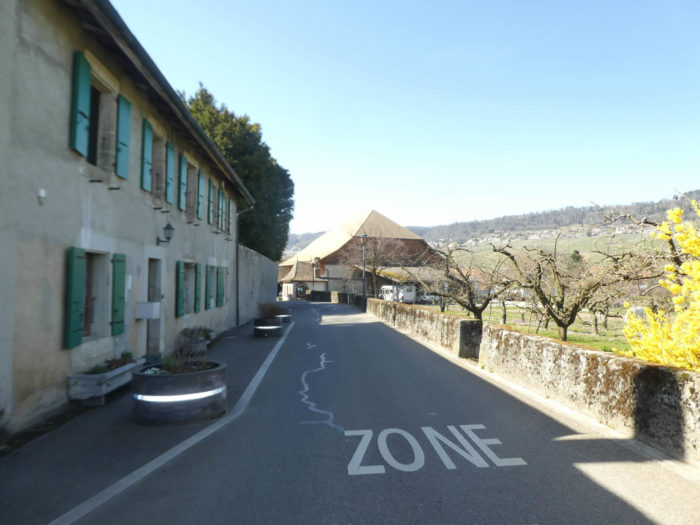 |
| This village, a true wine-growing gem, displays its treasures: sturdy and patrician homes, cellars, and taverns where wine, synonymous with life and taste, permeates every stone, every breath of the village. |
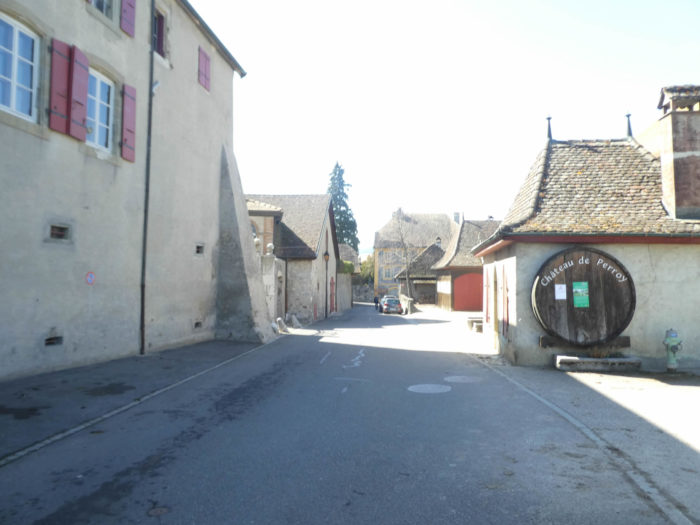 |
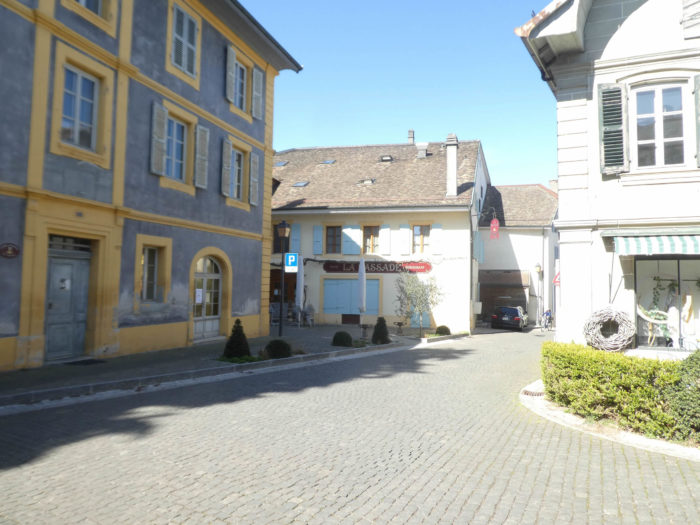 |
| In the heart of the 10th century, monks from Tournus, France, settled here, cultivating the hillsides and vineyards. The priory was erected at the beginning of the 12th century, and despite the vicissitudes of history and secularization during the Reformation, it remains, after various family vicissitudes and a purchase by the municipality in the 20th century, the jewel of a village that has preserved its wine-growing soul through the centuries. |
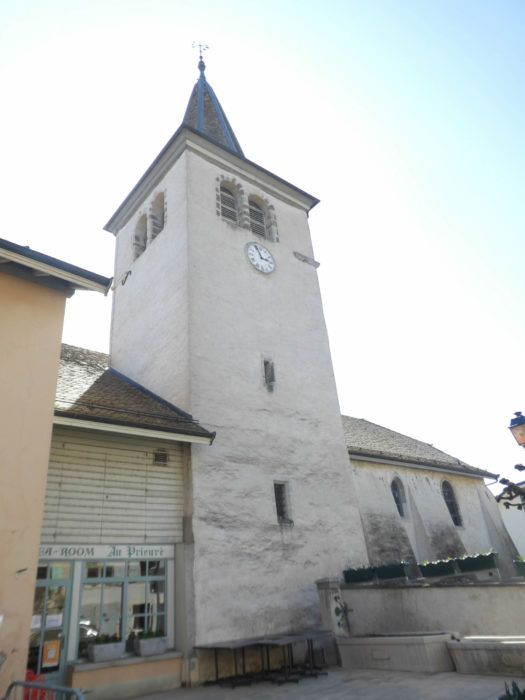 |
 |
Section 8 : Return to the lakeside
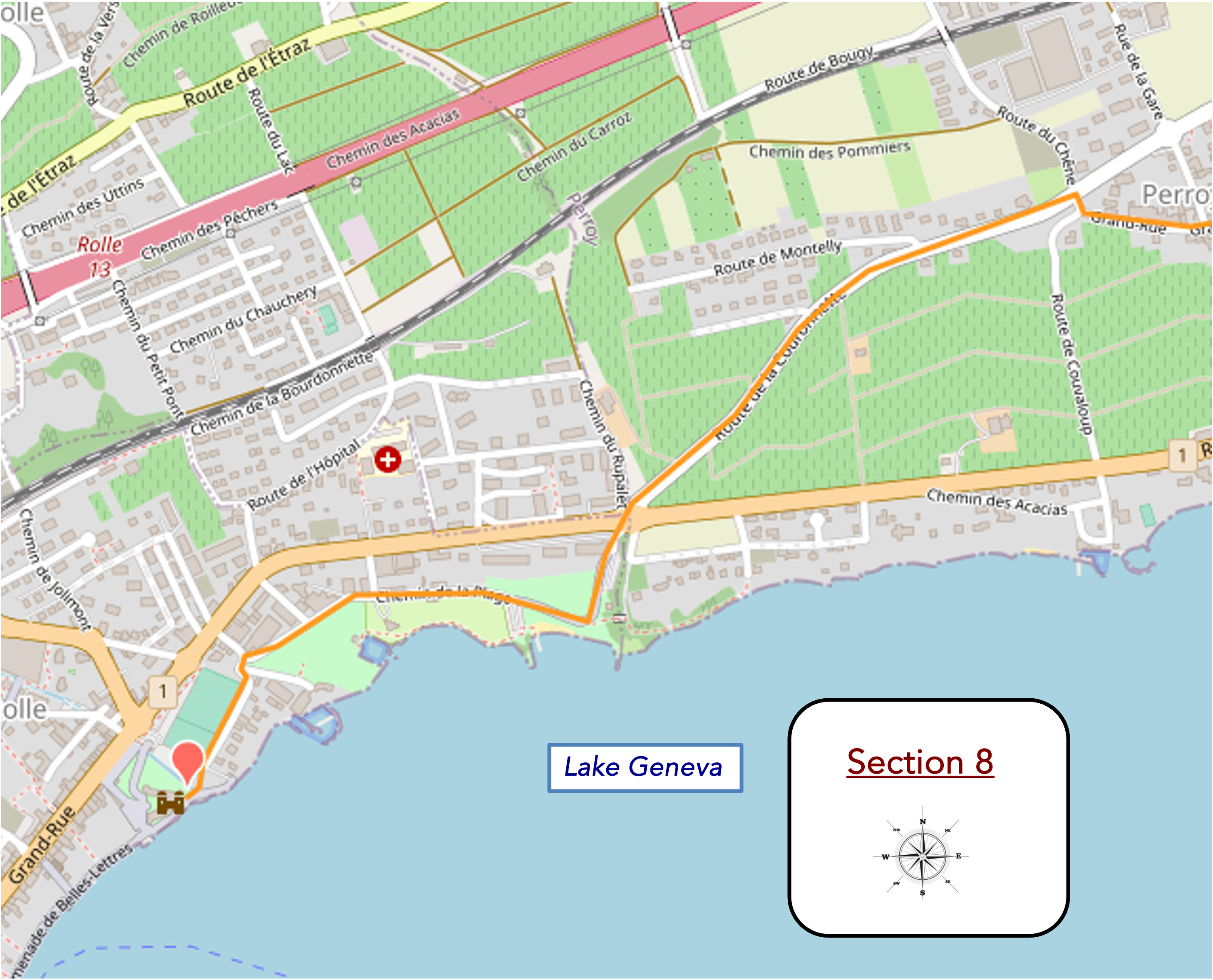
Overview of the route’s challenges : a route without any difficulty.

|
The Via Jacobi, like a manifestation of history, emerges from the vineyards of Perroy. Here, where the vine stocks adorn themselves with lush greenery, Chasselas reigns supreme in the prestigious appellation of La Côte. Red wines, modest by comparison, offer their discretion to this symphony of flavors. The gentle hills undulate under the benevolent gaze of the sun, and the traveler’s soul is enveloped in an atmosphere imbued with serenity.
|
 |
 |
| Less than two kilometers away, the bustling heart of Rolle is revealed. The Via Jacobi, like a graceful dancer, descends the road for nearly a kilometer, offering striking panoramas of vineyards stretching towards the horizon, caressing the shimmering shores of the lake. Each step reveals a new tableau, a new harmony where the vibrant colors of the landscape mingle. |
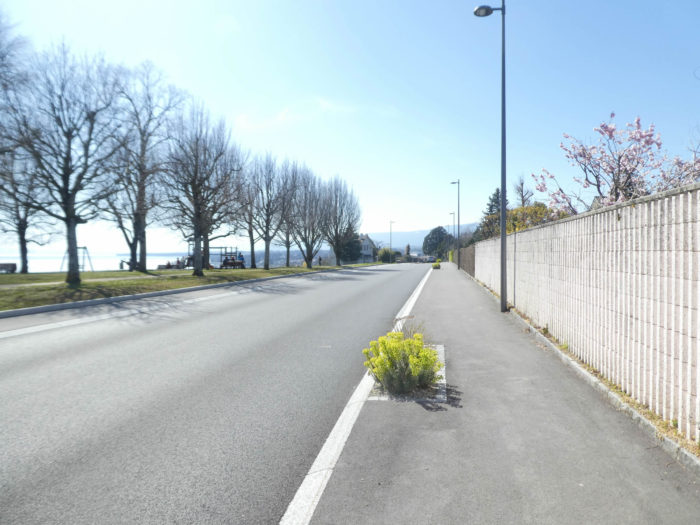 |
 |
The slope, sometimes steep, poses no obstacle to the walker.
|
 |
 |
| At the foot of this descent, the Via Jacobi joins the major national road, the Swiss Route, at the Couronnette crossroads, where the crystalline waters of the Rupalet stream murmur their ancient secrets. |
 |
 |
| The beach of Rolle, nestled in a green setting, comes alive under the first spring rays. The large park, a haven of peace and joy, welcomes the eager crowd seeking Sunday delights. The atmosphere is charged with excitement and goodwill, while the murmur of the lake echoes with children’s laughter. |
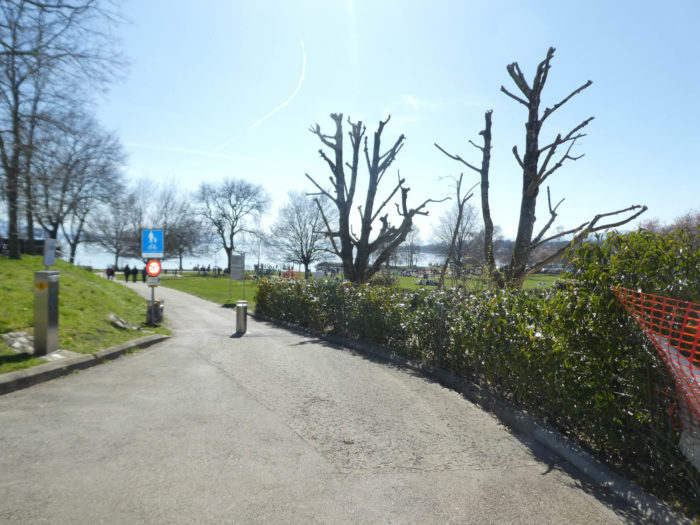 |
 |
| Less picturesque is the route that unfolds upon leaving the park, where the Via Jacobi, like a shooting star, crosses the industrial zone, overlooking the sleeping campground. Despite this less enchanted interlude, the traveler continues their quest towards the city center. |
 |
 |
And then, like a mirage emerging from oblivion, stands before the walker the castle of Rolle. A stone monument with a venerable past, this medieval edifice from the 13th century, adorned with its 16th-century attire, now houses the murmurs of history and echoes of times past.

|
Within its ancestral walls lies the very essence of the municipality of Rolle, where life flows peacefully through cobbled streets and shaded squares. With its 6000 souls, Rolle reveals its discreet charm, its treasures buried under the veils of time. The main street, a living artery, beats to the rhythm of the steps of residents and visitors, attesting to the richness and diversity of this city with a quiet past. Tomorrow, you will pass by the magnificent jetty.
|
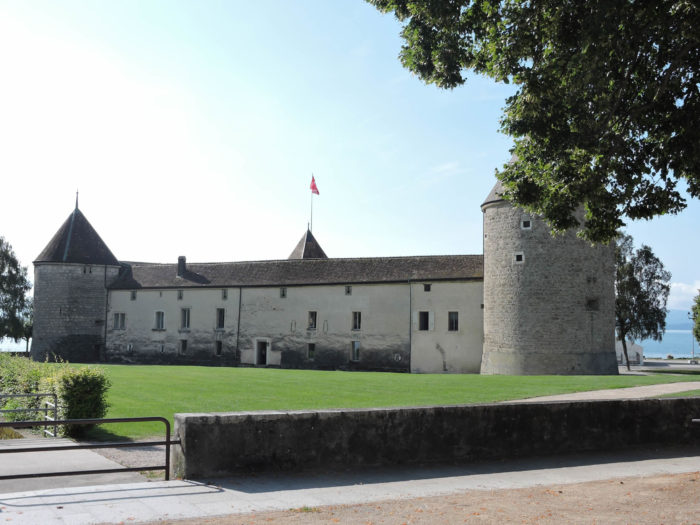 |
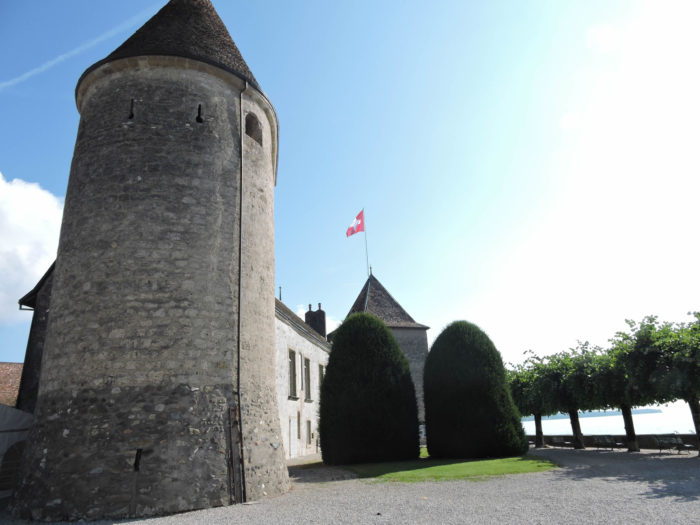 |
Accommodation on Via Jacobi
- Famille Eggenberger, Allée du Rionzi 16, Préverenges; 021 701 38 57/079 703 95 92; Accueil jacquaire
- Henri Duboux, Ch. De la Taudaz 6, Préverenges; 021 801 20 56; Guestroom, breakfast
- Ans Aquilar, Chemin Neuf 27, Préverenges; 021 801 31 76/076 328 31 76; Guestroom, dinner, breakfast
- Famille Spirig, La Gottaz 24, Morges; 021 799 39 03; Accueil jacquaire
- Anne Marie Moussou, La Gottaz 8, Morges; 021 802 10 01; Guestroom, breakfast
- Katharina Besençon, Rue des Uttins 24, Morges; 021 803 30 36/079 303 35 50; Guestroom, breakfast
- Véronique Bornand, Avenue Auguste Forel 6, Morges; 079 648 58 88; Guestroom, breakfast
- B&B Adler, Reneveyres 14B, Morges; 021 801 89 10/076 492 20 44; Guestroom, breakfast
- Hôtel de la Longeraie, Route de la Longeraie, Morges; 021 804 64 00; Hotel***, dinner, breakfast
- Hôtel de la Nouvelle Couronne, Passage de la Couronne 2, Morges; 021 804 81 81; Hotel***, dinner, breakfast
- Janine Göcking, Rue du Pont-Levis 16B, St Prex; 079 347 43 87; Guestroom, breakfast
- Claire Lise Champendal, Ch. de Vergognausaz 7, St Prex; 021 806 30 35/079 249 06 69; Guestroom, breakfast
- Rose-Marie Zbinden, Chemin de la Liberté 12, St Prex; 021 806 20 21/078 617 71 20; Guestroom, breakfast
- Guy Marmet, Ch. De la Vigne 4, Allaman; 021 807 31 67/079 351 33 49; Guestroom, breakfast
- Berger-Bettex, vigneron, Château Rochefort, Allaman; 021 807 31 49; Guestroom, breakfast
- Les Margelles, Route suisse 4, Allaman; 021 807 32 43; Guestroom, breakfast
- Olivier et Denise Rey, Ch. De Sus-Craux 12A, Allaman; 021 807 39 61/079 779 31 45; Guestroom, breakfast
- Château Rochefort, Place de l’Eglise 1, Allaman; 079 628 36 83; Hotel, breakfast
- Paillard Christian, Route de Montelly 19, Perroy; 021 825 26 16/079 451 98 21; Accueil jacquaire
- Claire Martin, Ruelle des Jardins 8, Perroy; 021 825 10 39/079 444 30 54; Guestroom, breakfast
- Christel Daniels, Ch. Du Sus-Craux 23, Perroy; 079 695 02 75: Guestroom, breakfast
- Camping de Rolle, Rolle; 021 825 12 39; Camping
- B&B Breit, Grand Rue 18, Rolle; 021 825 21 08/079 384 68 31; Guestroom, breakfast
- B&B Le Courtil, Rue du Port 14, Rolle; 021 822 42 42; 021 822 42 42; Guestroom, breakfast
- B&B Au bonheur des Iris, Avenue G. Guisan 64, Rolle; 076 202 94 49; Guestroom, breakfast
- Hostellerie du Château, Grand Rue 16, Rolle; 021 822 32 62; Hotel*, dinner, breakfast
Finding accommodation on this stage shouldn’t pose major difficulties. You’ll be in cities with all the necessary amenities. However, it’s still wise to make reservations for peace of mind.
Feel free to add comments. This is often how you move up the Google hierarchy, and how more pilgrims will have access to the site.
|
 |
Next stage : Stage 18: From Rolle to Coppet |
|
 |
Back to menu |






















